Programs and Services for Creating a Family Tree
Updated: November 7, 2024 Author: Vitaly
In this article, we will explore the best programs and services for building a family tree, which offer convenient and intuitive tools for creating and managing digital heritage. We will highlight their main features, advantages and capabilities to help you choose the most suitable program for your needs.
Creates stylish Family Tree that is immediately ready for printing
Access to a huge database of historical documents for free.
Creating a family tree is an important and meaningful journey into the past that allows us to better understand our own history and connections to our ancestors. In the past, this process was more labor-intensive and complicated. However, thanks to new technologies and programs, creating a family tree today has become much simpler and more convenient.
Now there are many programs and services that help you create and maintain your own family tree. They offer a variety of functions, from entering basic information about relatives to adding photos, documents, digital records and other important materials.
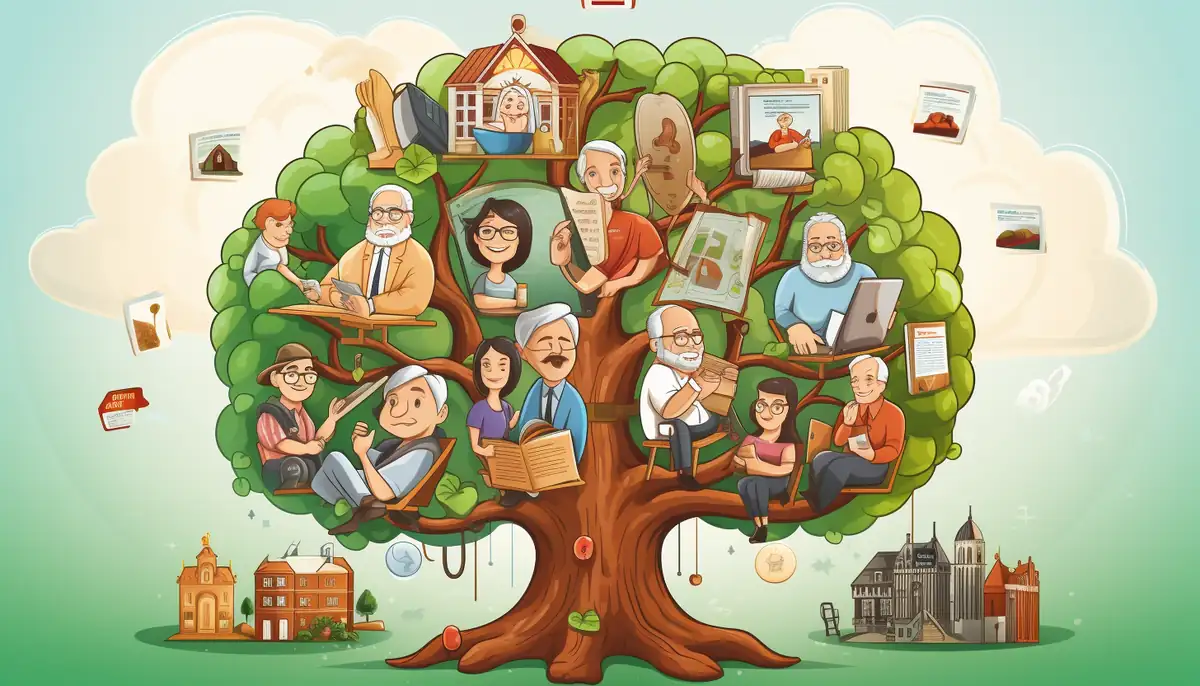
One of the main jobs that these programs and services do is preserving the memory of ancestors in photographs, various archival records, letters and documents. More and more, this data is stored on computers and in the cloud.
Using a family tree software, we can create a detailed database of our family where all this material can be preserved and accessible for both present and future generations.
Some of us spend a lot of time researching genealogy records, talking to relatives, and digging through old photo albums to learn more about our ancestors. Now, thanks to programs and services, we have the opportunity to collect and organize all this information on a platform that helps us build a complete and detailed family tree.
Evaluation criteria
Choosing a program to compile your family tree depends on your goals and what you want to achieve. You might want a simple and stylish photo template that displays a small "branch" of your family - like a school project featuring your parents and grandparents.
On the other hand, you may be interested in building a larger tree that goes back further to your great-great-great-grandparents and includes the newest generation. You may want to add numerous "branches" for first and second cousins, stepfathers, stepmothers, ex-spouses, and half-siblings.
No matter your goals, our review contains various programs and services that will help you succeed. However, each program may have a different approach based on various factors. All those factors have been taken into account in our rankings.
Our rating includes a variety of tools, and most can be used together with just a few exceptions. You can create the main trunk of your tree, and then connect other relatives, both close and distant. This way, you can enhance your family tree by adding new branches and correcting previously entered information.
When choosing the best family tree software, it is important to consider a few key criteria to make your experience smooth and enjoyable.
Ease of use
The first thing you should pay attention to is how friendly the interface is and how easy it is to use. It’s important that beginners can quickly understand how to use the program. A user should be able to go into an application or website and quickly create a simple tree in 15-20 minutes. Having a variety of additional features can also make the process more convenient.
Import data
Another key feature is the ability to import information from other sources. Most international programs use the GEDCOM standard, which allows you to transfer data between different services.
Completeness of information
It is important how detailed the information about each family member can be. This includes adding photos, interesting facts, and descriptions of family and other relationships such as remarriages, adoption, or even conflicts between family members.
Availability
The programs and services you consider can be free or paid. Keep in mind that access to tools may be permanent or limited by certain conditions, like complex registration, subscription requirements, or the need for a stable Internet connection.
Ready to print
The user should be able to create attractive visualizations of their family connections. Consider how easy it is to create a visual family tree, and whether you have a choice of templates and styles for high-quality printing.
Database Access
It is important to evaluate the possibility of connecting to third-party sources to access archival documents, photographs or existing family trees, which can greatly enrich your information.
General impression
A simple yet significant evaluation criterion is to ask yourself: “Would I recommend this program to a friend or acquaintance?” Your overall impression about a service can have a huge impact on its popularity.
These criteria were used when rating the programs and services we reviewed. Of course, the rating is exclusively subjective, because what may be a drawback for one person might not matter to another. . Ultimately, it's crucial that you choose what works best for you based on convenience, practicality, and the goals you set when developing the program. We have compiled a list of options and highlighted their pros and cons to help you make your choice easier.
Tonfotos
The Tonfotos program differs from other representatives of this TOP because tits main focus is on organizing and searching your photographs, rather than just providing text information about family members. However, starting with version 1.10.0, Tonfotos can build family trees that are immediately ready for printing, which sets it apart from many genealogy-focused solutions. In this case, the resulting image is interactive, allowing users to rebuild it by right-clicking and selecting another person as the starting point.
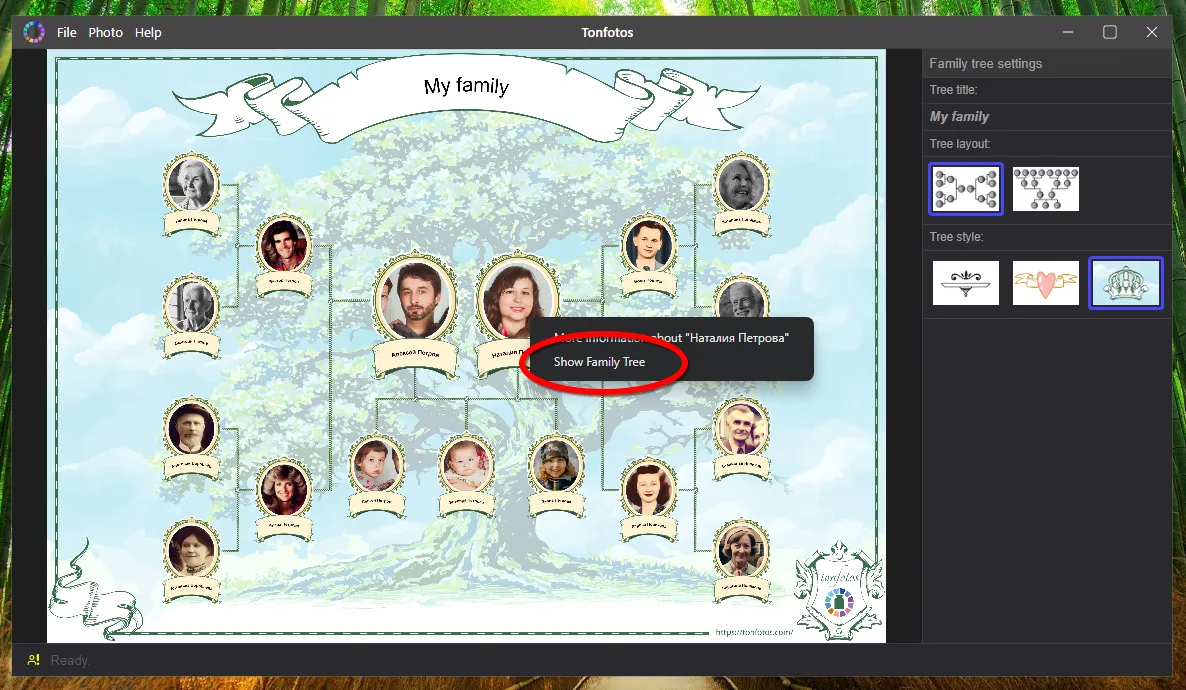
Tonfotos offers two display options: "Bowtie" and "Hourglass." The choice depends on the level of detail you want. “Bowtie” is suitable for showing the main couple, their children and two generations of ancestors. "Hourglass" displays the entire collected genealogy of the family.
Additionally, the program can create profiles of individual persons, where you can include extra information like their occupation, contact details, and educational institutions, along with other relatives.
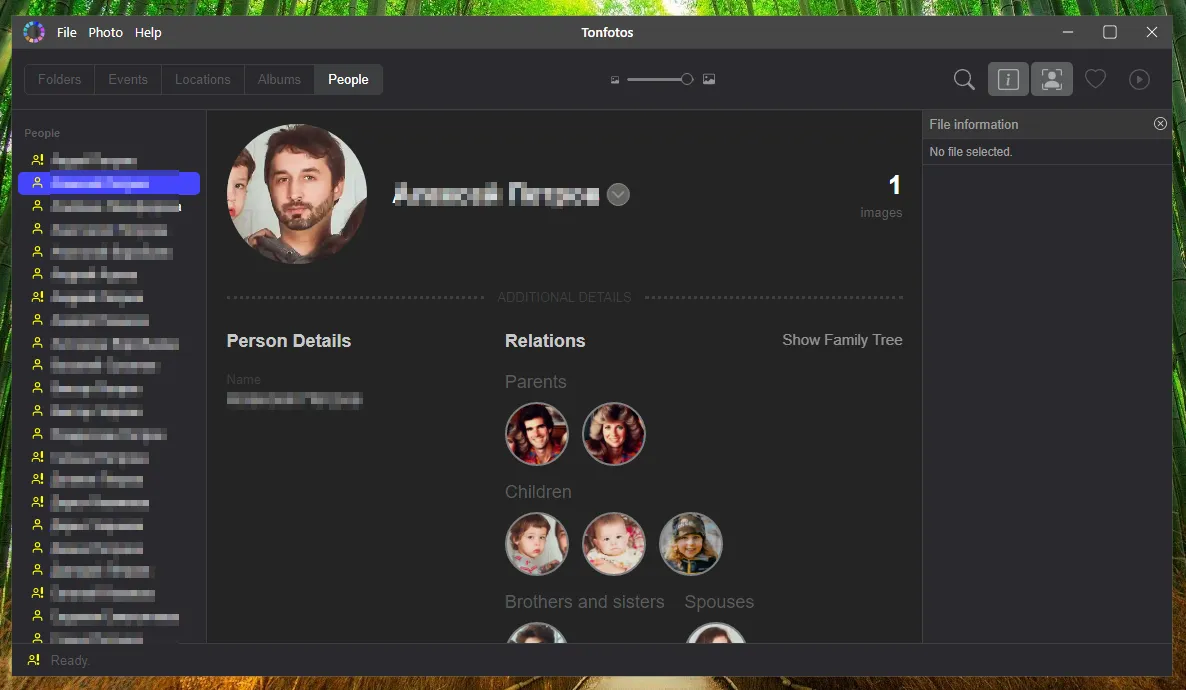
It’s important to highlight the built-in neural network for facial recognition ,which can find and tag people in all photographs in the photo archive.

Advantages and disadvantages of the program
- Automatically recognizes people's faces in all your photos
- Allows you to reorganize and easily browse large family photo collections
- Multiple users can work together on the photo archive, tagging people and adding information simultaneously, with automatic synchronization of changes
- There is a free version that has no restrictions on functionality, but users can create no more than 12 person profiles.
- You can quickly create a high-resolution print-ready family tree for any person, choosing the style and kind of template.
- You can create profiles with personal information, and the system will automatically make a personal album that includes all photos of this person, using facial recognition.
- Events can be shown on a world map, searching by people, dates, folder and file names, tags, etc.
- The program focuses mainly on the archive of photographs and the faces of the people.
- The amount of information you can add to a person’s card is somewhat less than in services focused specifically on genealogy.
MyHeritage
MyHeritage is a well-known service that offers various tools for genealogical research and building a family tree. It also uses neural networks to process and animate historical photographs. MyHeritage has access to databases of archival documents, photographs, and newspaper entries. The only problem is that most of these features, other than manually creating a family tree, require a paid subscription.
The rearranged service can be a great tool for your own genealogical research. The interface is user-friendly and each profile can include a lot of additional information.
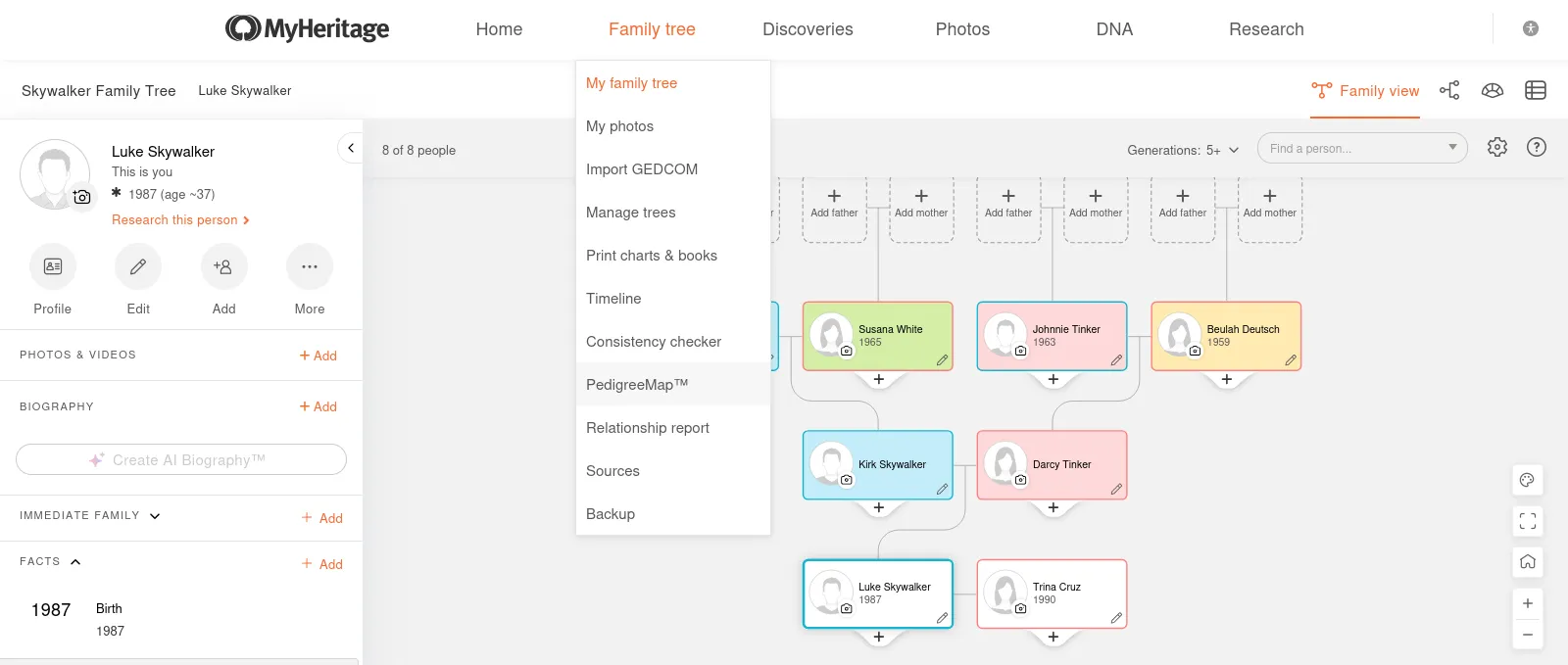
If you previously worked with another service or program, you can easily import all data by exporting/importing a GEDCOM.
MyHeritage offers a wide variety of templates for creating a printable family tree, but you can only export the generated image after buying a subscription.
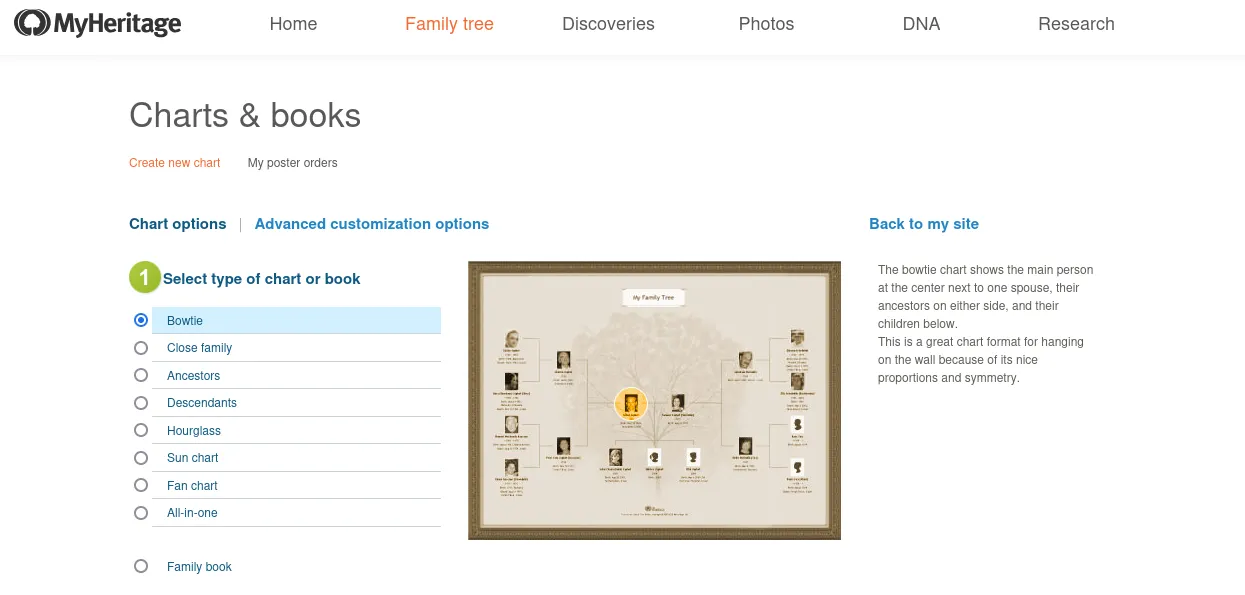
It's also worth mentioning the free Family Tree Builder program developed by MyHeritage. It is an effective tool for collecting and structuring information about ancestors. With its help, you can not only build a family tree, but also conduct full-fledged genealogical research.
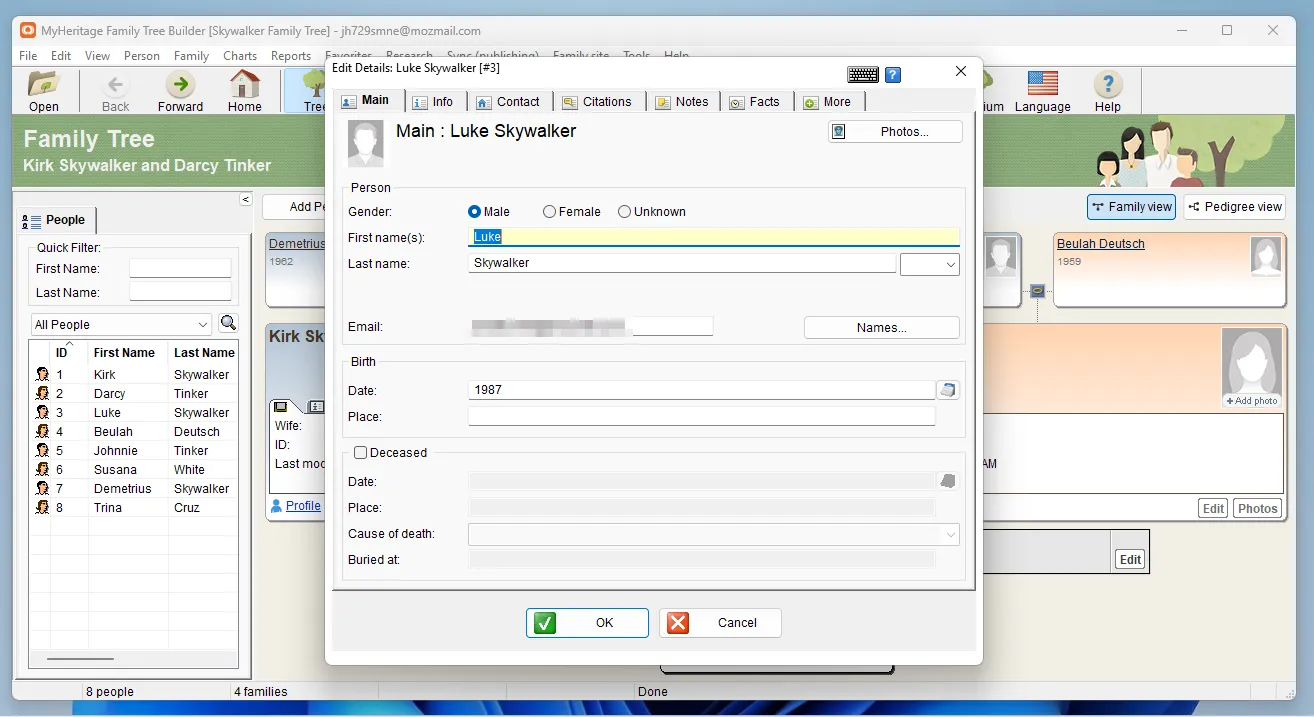
The program synchronizes with the MyHeritage cloud and can import and export GEDCOM files. Besides, you can print your family tree for free. You can even select the format (PDF or JPG) in which the image will be saved.
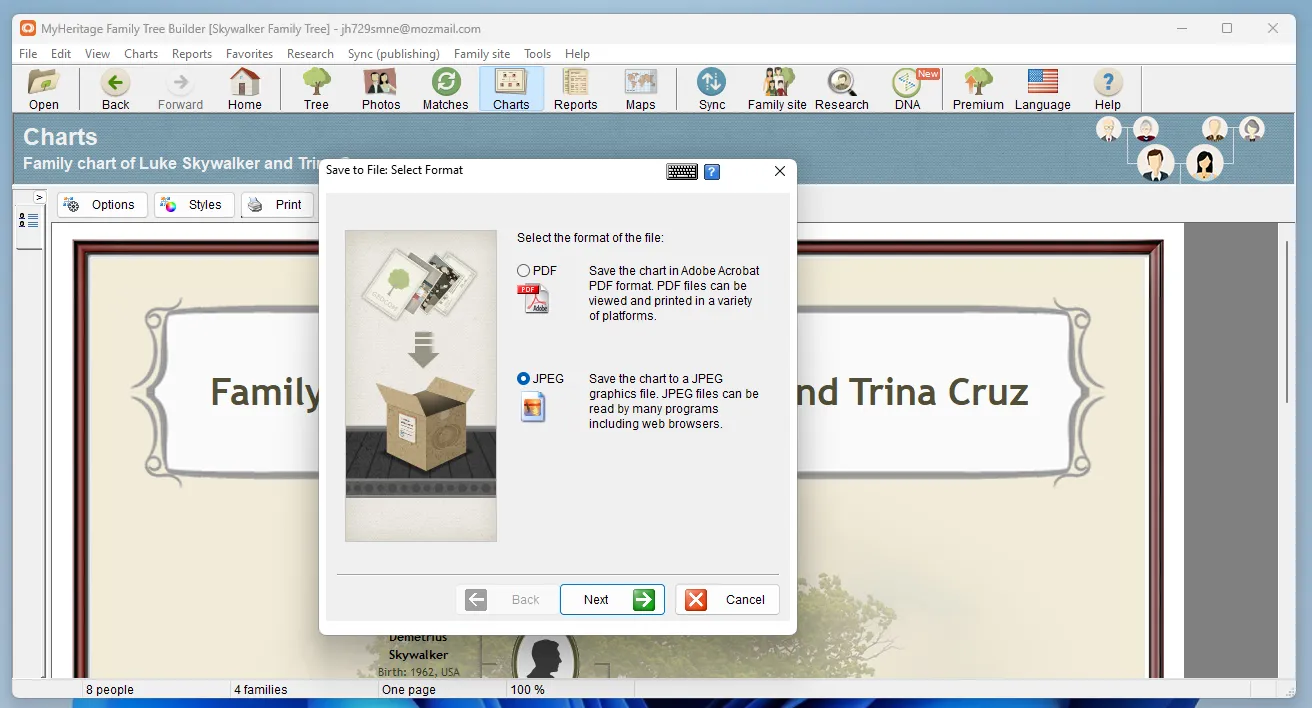
Advantages and Disadvantages
- MyHeritage provides extensive functionality for building a family tree and conducting a genealogical research, including tools for working with archives, newspaper records and photographs.
- One unique feature is the ability to animate historical photographs, allowing users to bring images of their ancestors to life and add emotional value to research.
- The Family Tree Builder program has all the necessary tools for professional genealogical research. Thanks to the functions of identifying people in photos and reading geotags, it can be used to create family photo archives.
- Although MyHeritage requires payment to create beautiful family tree images, this feature is available for free in the Family Tree Builder app.
- While Family Tree Builder is available, all online features require a subscription, which can be a barrier for users looking for free solutions.
FamilySearch
FamilySearch is a non-profit project developed by The Church of Jesus Christ of Latter-day Saints. It offers all the features needed to create a family tree and access to a huge database of historical documents for free. However, this does not affect the functionality of the service. The process of creating a family tree in FamilySearch is simple and intuitive. New users can easily add basic relatives using a primary settings wizard.
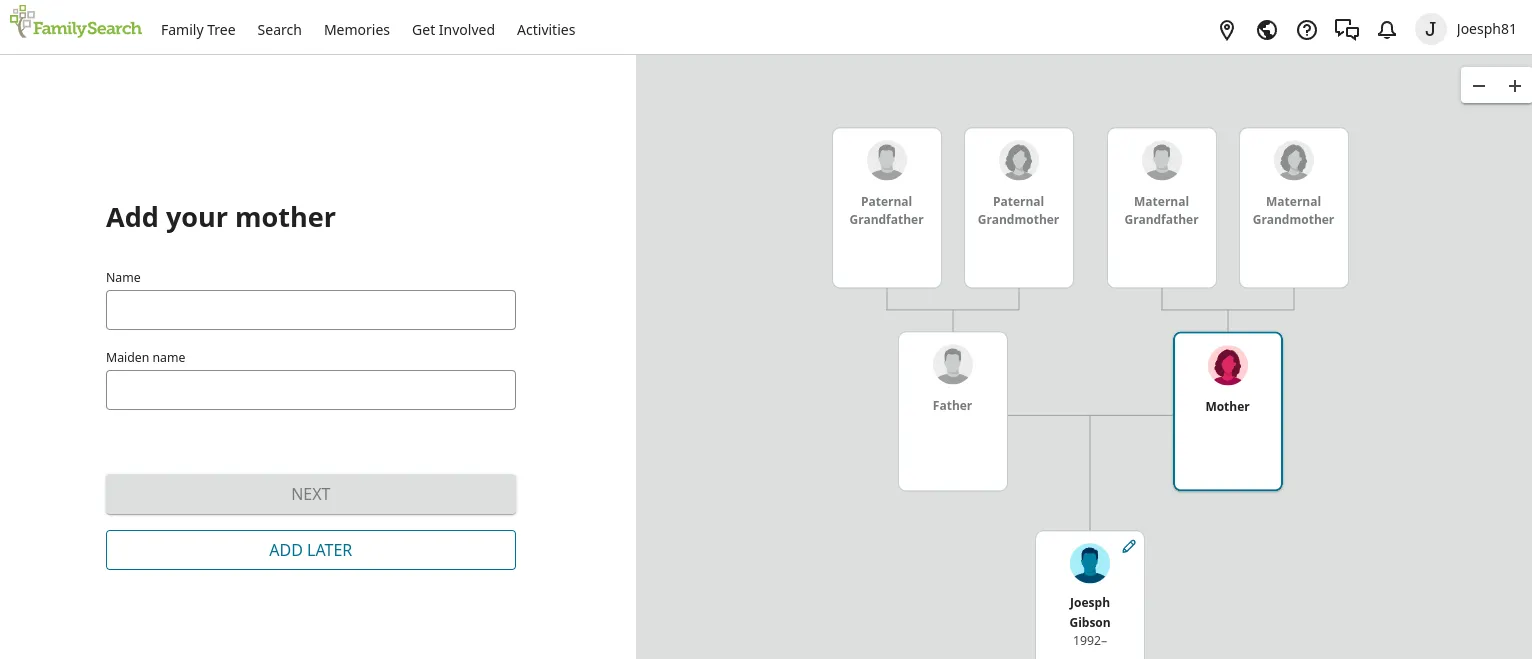
After entering basic information about each person, the user can add details about those people and their life path by editing their personal card. Here you can start searching for documents in the historical databases of both FamilySearch itself and other services.
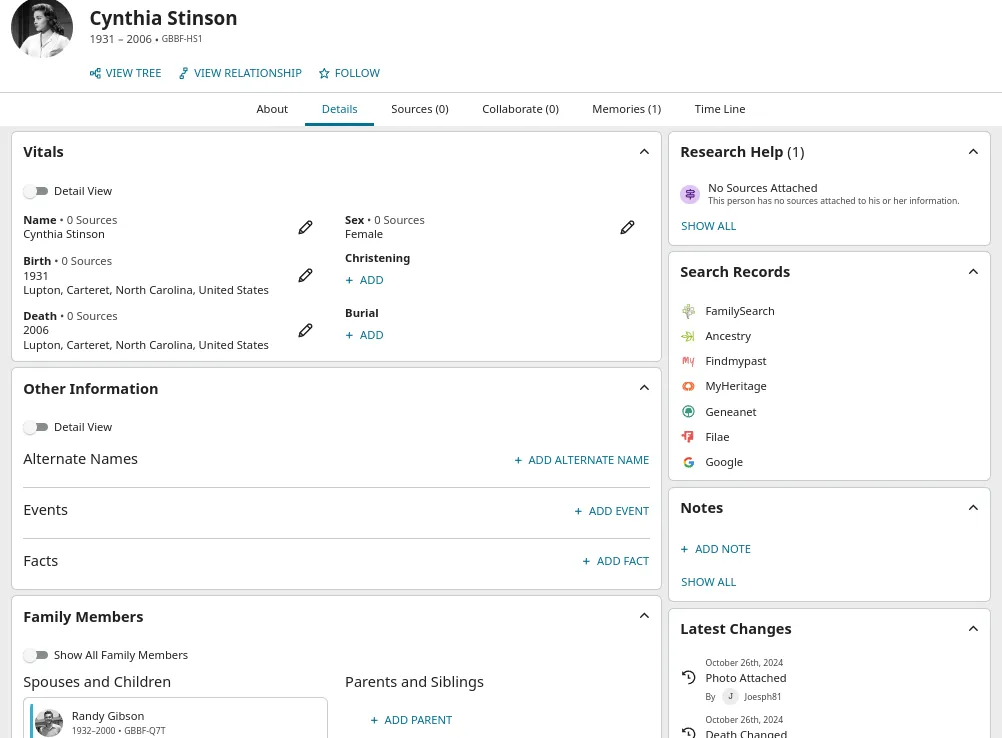
There is a Gallery where all images can be sorted depending on the content.
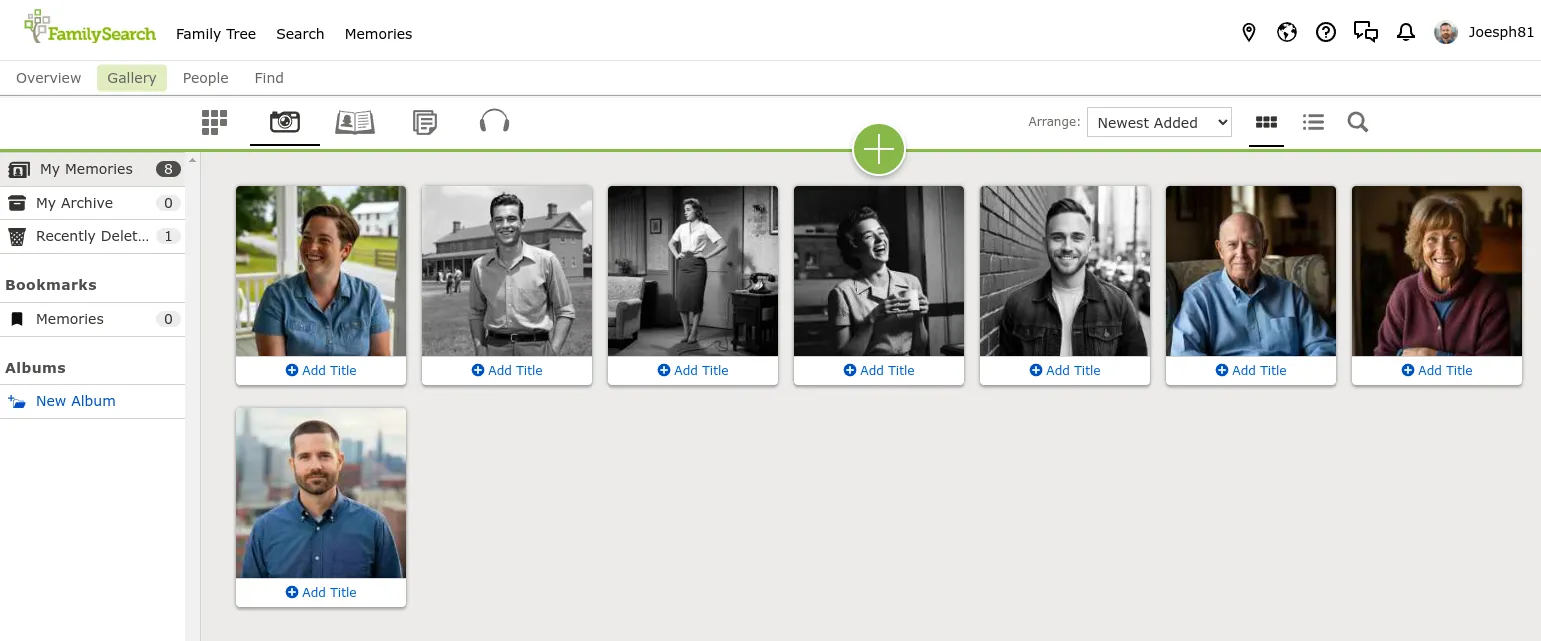
There is a simple photo metadata editor where you can tag a person, add a description, comments or other additional tags.
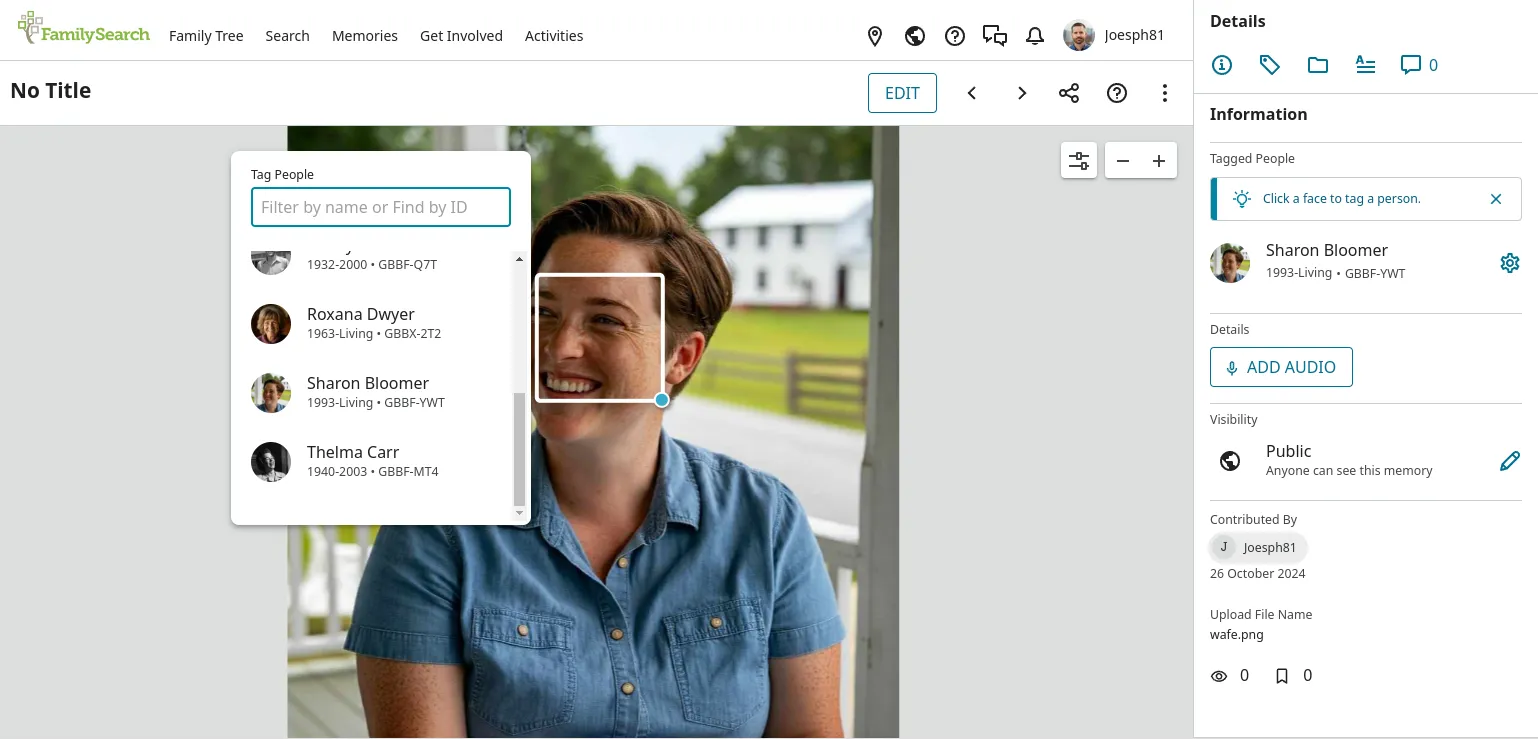
There are different options for visualizing family connections, and the Print button allows you to export the tree as a PDF file.
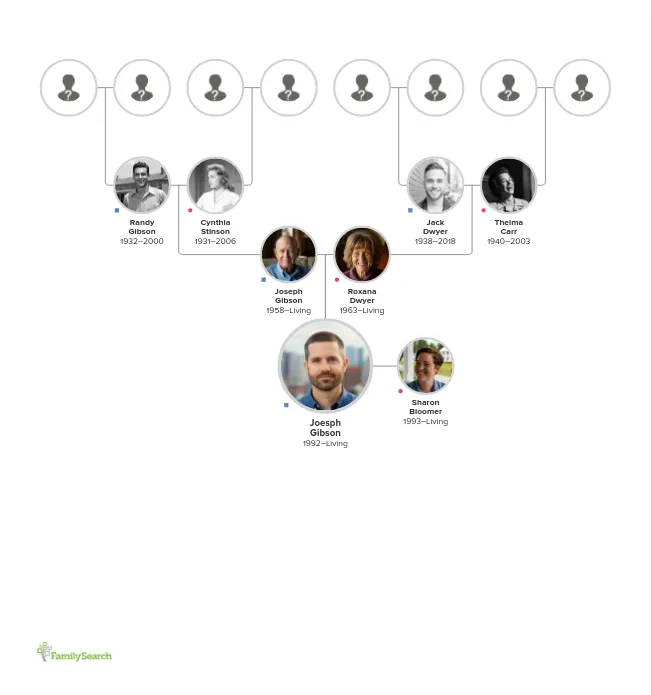
Advantages and Disadvantages
- FamilySearch is completely free, which sets it apart from many paid genealogy services.
- The service offers billions of records from over 200 countries, including church, civil, military, immigration and other types of data.
- The Record Hints tool finds records that may be related to your family tree, making it much easier to find information.
- The program doesn’t support the GEDCOM file, so you cannot export data from other genealogical services and programs.
- PDF format is not suitable for printing.
Ancestry
With Ancestry, you can do more than just build an interactive family tree; you can conduct comprehensive genealogical research of your own. The service provides access to various databases of archival documents and photographs, and also has its own DNA lab.
After registration, you will have to choose a subscription plan, each including different options. However, if you only need to build a family tree, there is a free plan available. This plan includes basic editing functions and access to 1 billion archived records instead of 4 billion with a premium subscription.
Despite its extensive functionality, Ancestry is easy to use. The Family Tree Initial Setup Wizard guides you through everything and shows the main capabilities of the service.
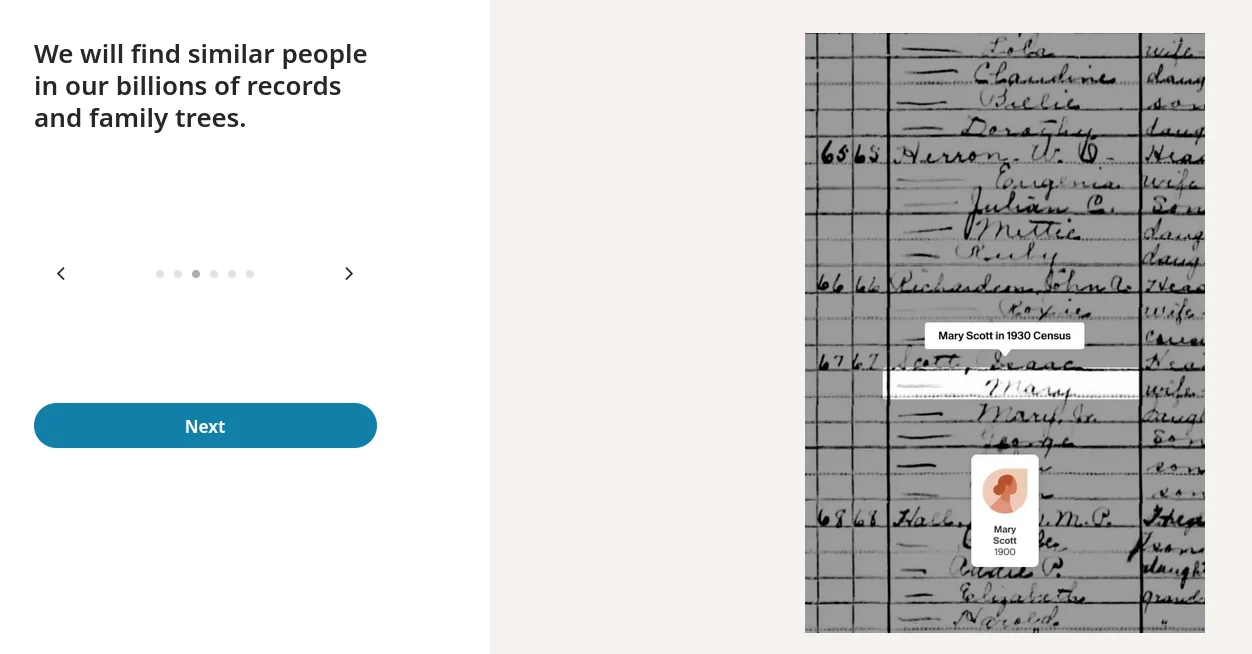
When you enter your first name, last name and place of residence of your ancestor, a search will begin automatically in the databases and the family trees of other users.
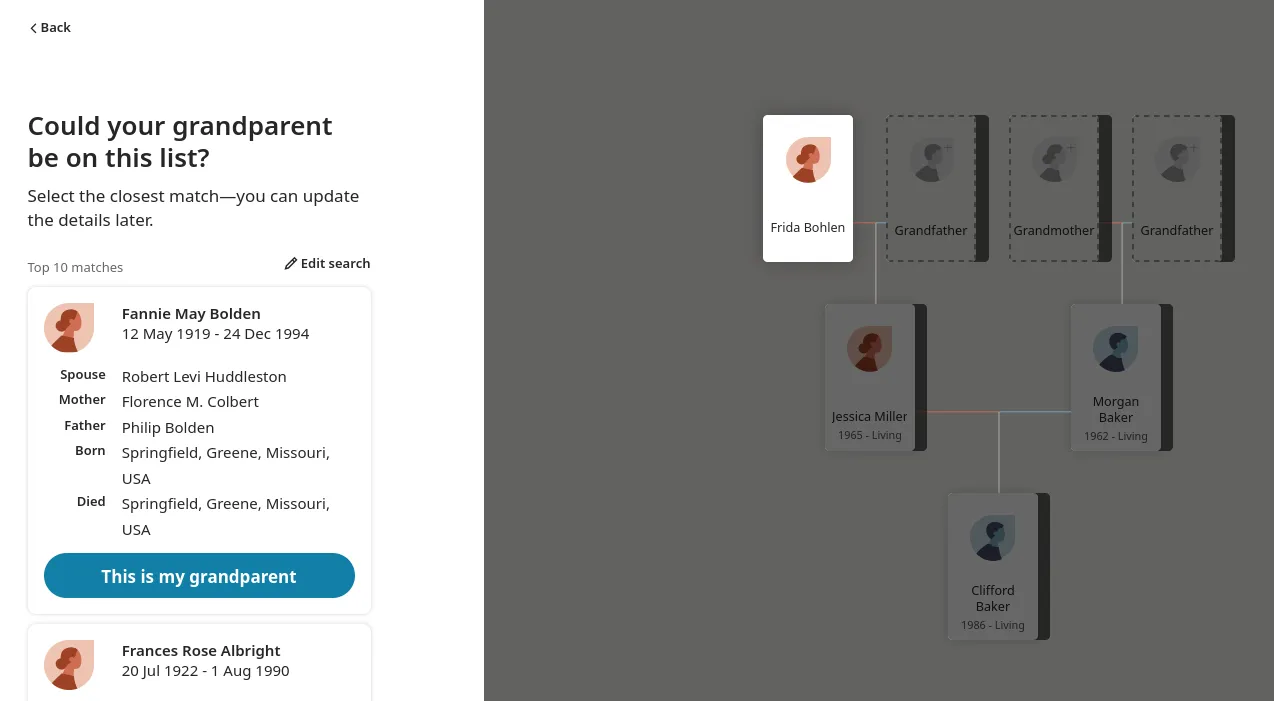
After adding key ancestors, you'll have the option to edit the tree and choose the best style for visualizing connections.
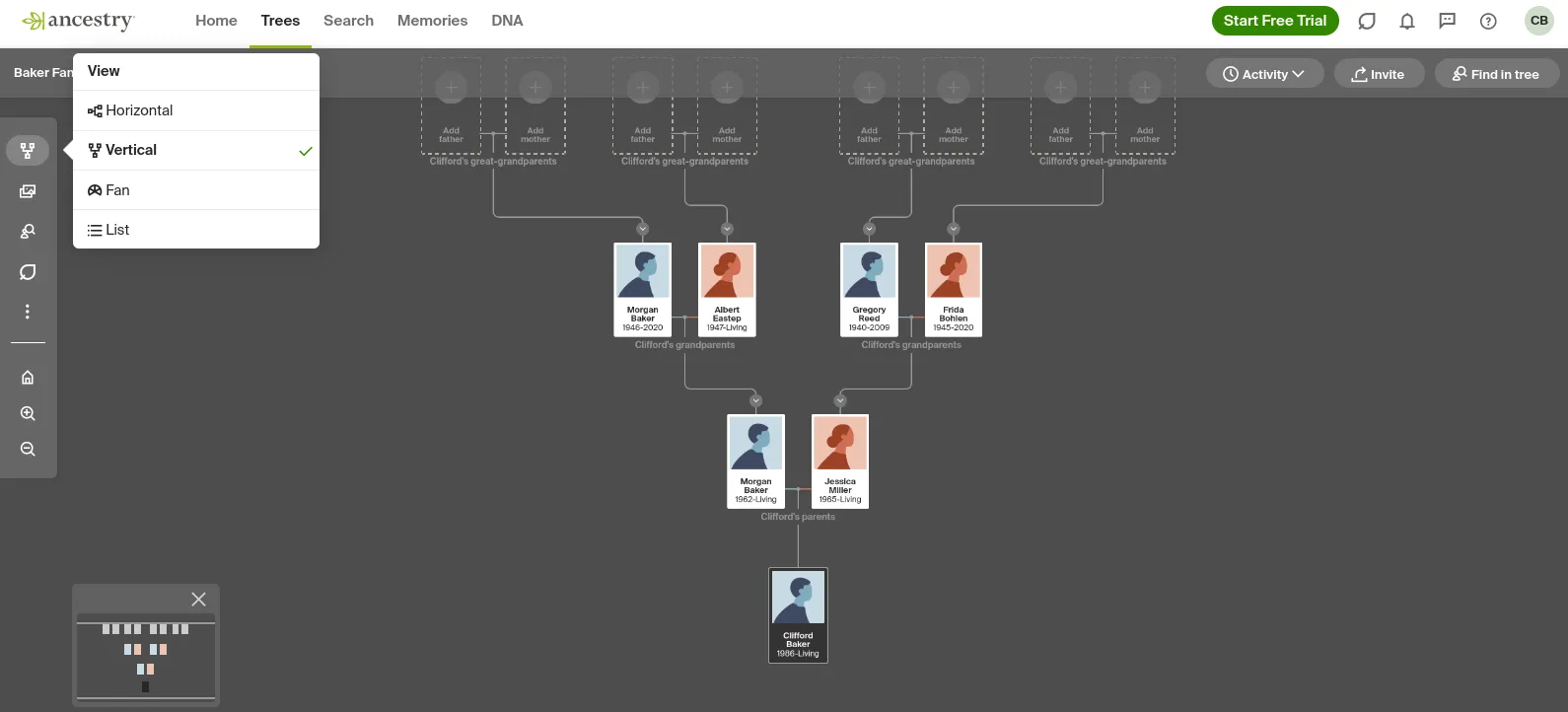
Each person's profile includes not only basic information, but also various facts from a person’s life. You can add photographs and documents that help illustrate their life story
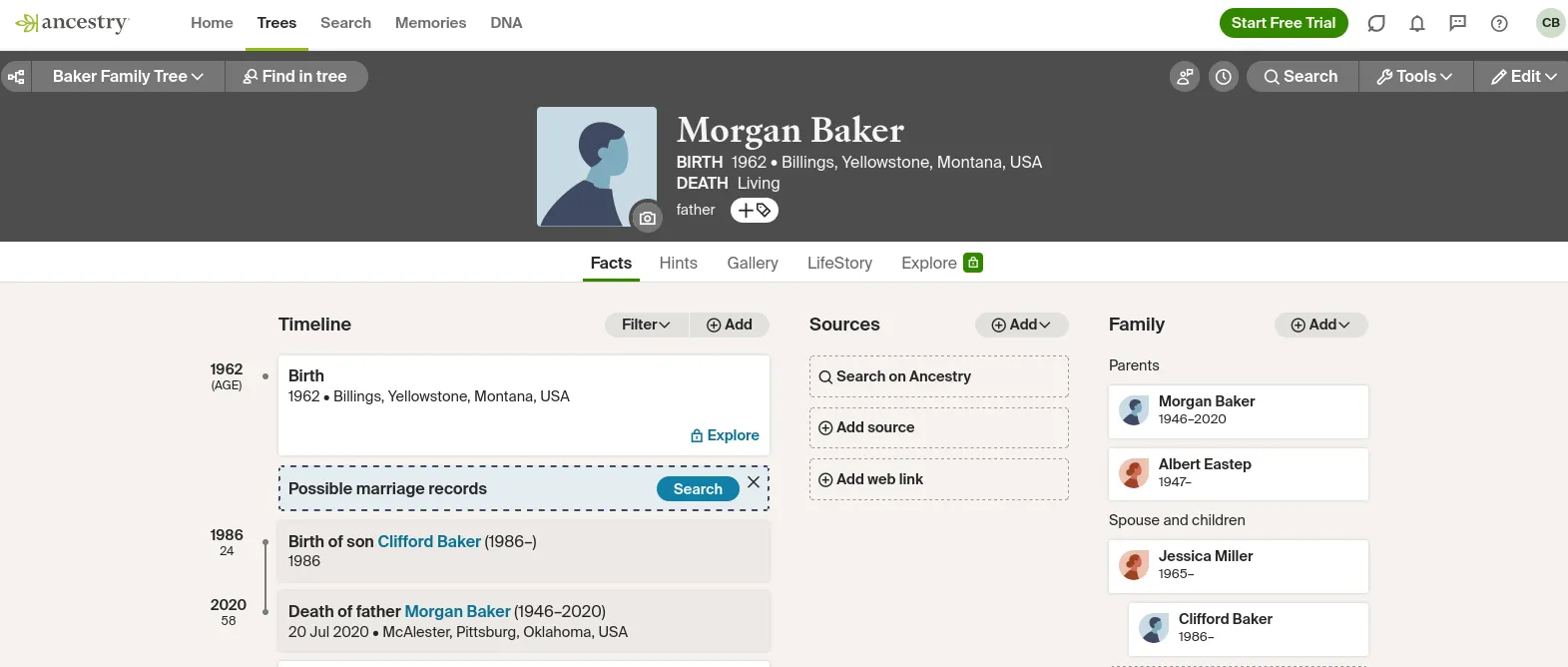
The print family tree function launches a standard browser tool, meaning the resulting PDF document will require some additional editing.
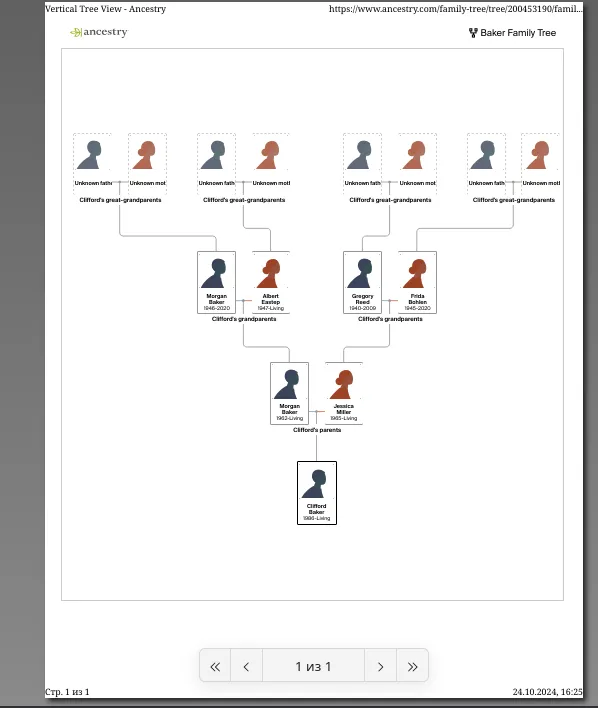
Advantages and Disadvantages
- Ancestry provides access to one of the largest databases with billions of historical records, including censuses, birth and marriage certificates, military records and more.
- AncestryDNA provides DNA testing to help users find distant relatives and explore genetic roots. These results can be integrated into a family tree.
- The platform makes it easy to create and edit a tree, add facts, photos and historical records. All data is stored in the cloud, so you can access your information from different devices.
- Ancestry automatically matches and suggests records that may apply to your family members, making it easier to find new information and expand your tree.
- Full access to the database and advanced features such as viewing historical records and performing DNA tests requires a paid subscription. For users who only need basic functionality, the price may seem high.
- The use of DNA tests and the storage of personal data raises some security and privacy concerns. Although Ancestry claims that they are protected, questions about safety remain relevant.
- The image received for printing the family tree is for informational purposes only and is not suitable as a gift or as a wall painting.
Findmypast
Findmypast is an easy-to-use family tree building service. The program allows you to build family ties and add all known information about a specific person. Moreover, everything is done online, which allows you to share the collected information with loved ones anytime.
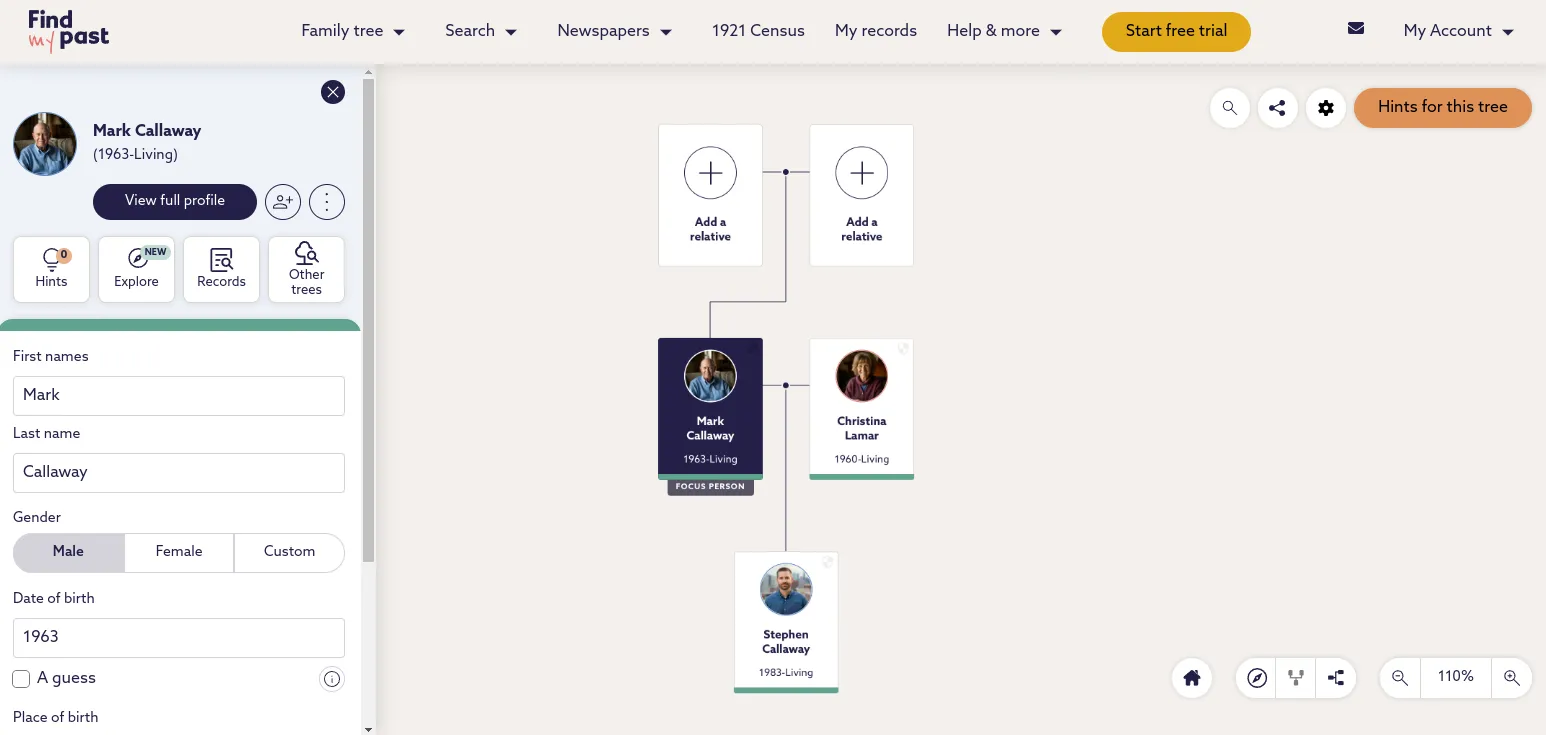
Users can add personal facts, photographs, and documents to create a complete picture of a person’s life.
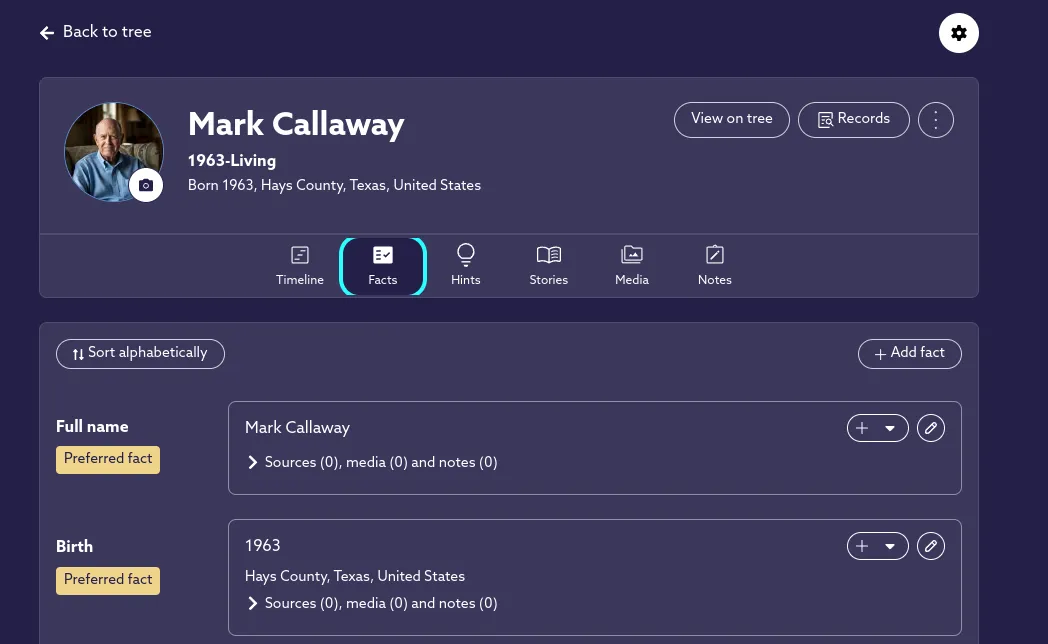
It is possible to create an image of a family tree, but this is done through a standard browser print tool, which means the final result isn’t as visually appealing as one might hope.
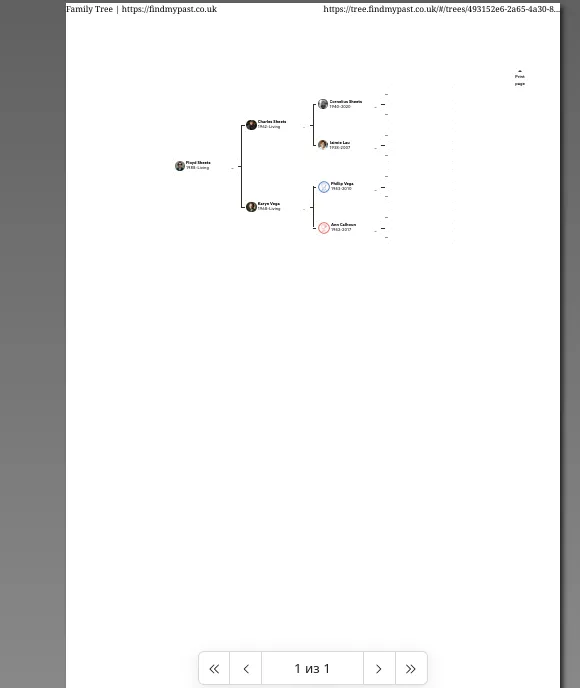
Findmypast offers basic features for free; you only need to subscribe if you want to access the database of archival documents, newspapers and magazines, even if the origin of your family is connected with North America, Great Britain, New Zealand or Australia.
Advantages and Disadvantages
- The user-friendly interface allows users to create and customize family trees, add ancestry information, and view possible matches.
- While Findmypast is great for British and Irish genealogy research, its database may not be very helpful for those searching for ancestors from other countries.
- There is no option to export and import family tree data, making it difficult to transfer information to other platforms.
- Detailed person profiles include basic information as well as images and life facts, helping to better understand your ancestors’ history and make the family tree more complete and meaningful.
Inherited
Heredis is a multifunctional program for genealogical research with a 30-year history of development. It is designed for users who want to conduct genealogical research at a professional level. The program allows you to cover all possible connections between people, including ex-wives/husbands, children from first marriage or adopted, relatives of the second and third kinship.
The Heredis interface is user-friendly, making it easy to add profiles, fill out detailed information about relatives, and manage multimedia. A key feature is the ability to use geolocation, which helps you track the migration routes of family members.
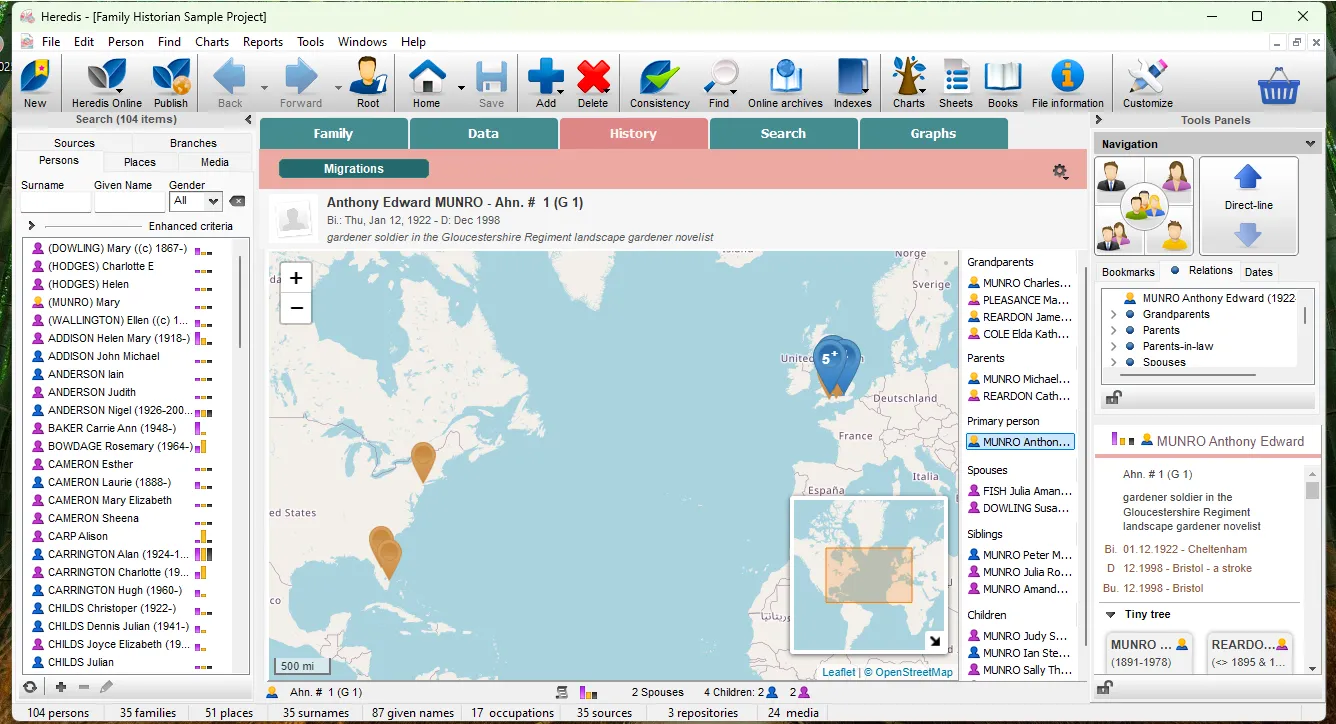
Heredis offers customizable family tree templates and designs, enabling users to create unique visualizations of family connections.
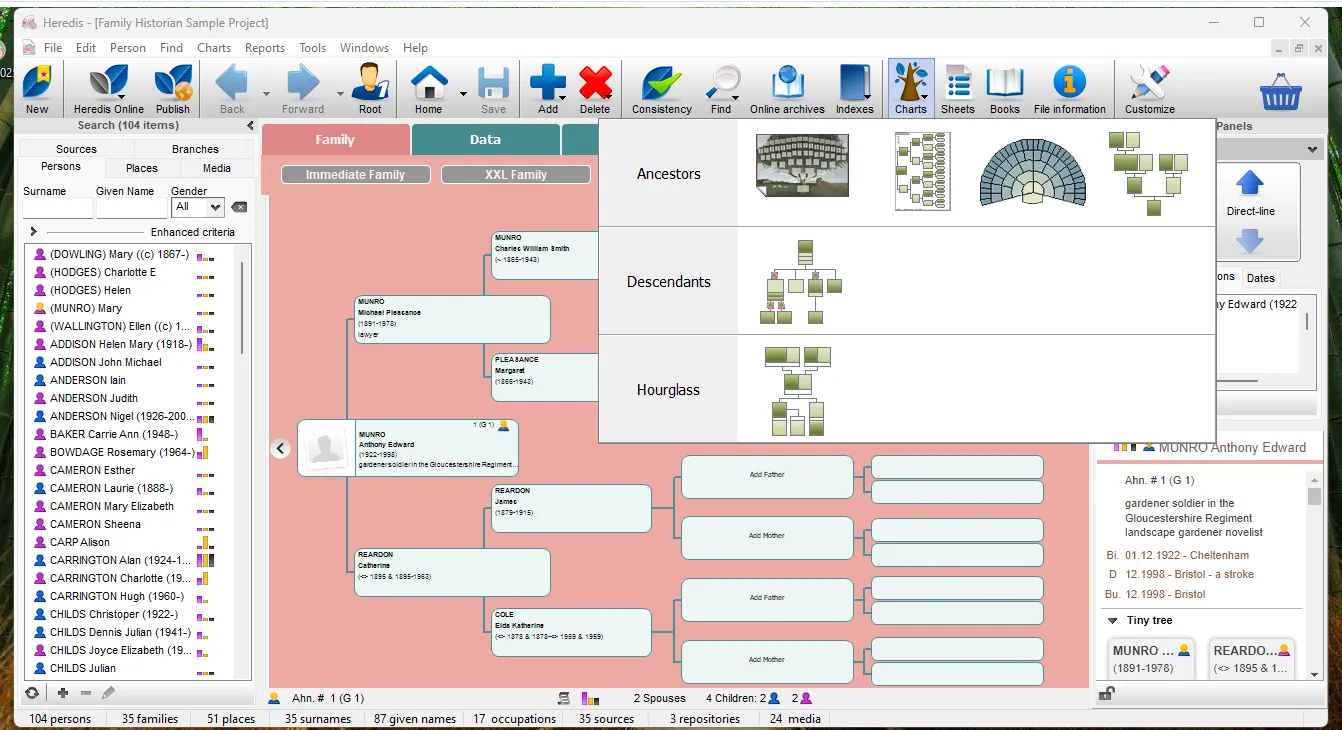
Heredis supports importing and exporting GEDCOM files, making it easy to transfer genealogical information from other programs. Users can synchronize their data between the desktop version and the project’s online service, which allows them to share their genealogical research with family members.
Advantages and Disadvantages
- Heredis has extensive family tree functionality, including design customization and geolocation, allowing you to track ancestor migration.
- The program provides a wide variety of family tree templates for printing, which gives users the opportunity to choose the best visualization option.
- The program supports the standard GEDCOM format, which allows you to transfer data between other genealogical programs.
- Heredis includes tools for searching and analyzing data, such as chronological and geographic maps, and pedigree charts, which help you deeply explore and visualize family history.
- Supports searches of information in various databases around the world, making it easier to find information about ancestors who lived in other regions.
- This is a paid program and you must pay extra for version updates.
Legacy Family Tree
- Wide functionality for genealogical research
- Integration with databases and GEDCOM
Legacy Family Tree is a free program for the Windows operating system, designed for family tree building and genealogical research. It was first released in 1997 after three years of development, and since 2017, it has been part of MyHeritage.
Despite its advanced age, the development of the program is slow, with a gap of up to 7 years between versions. This makes Legacy Family Tree's interface look outdated and confusing.
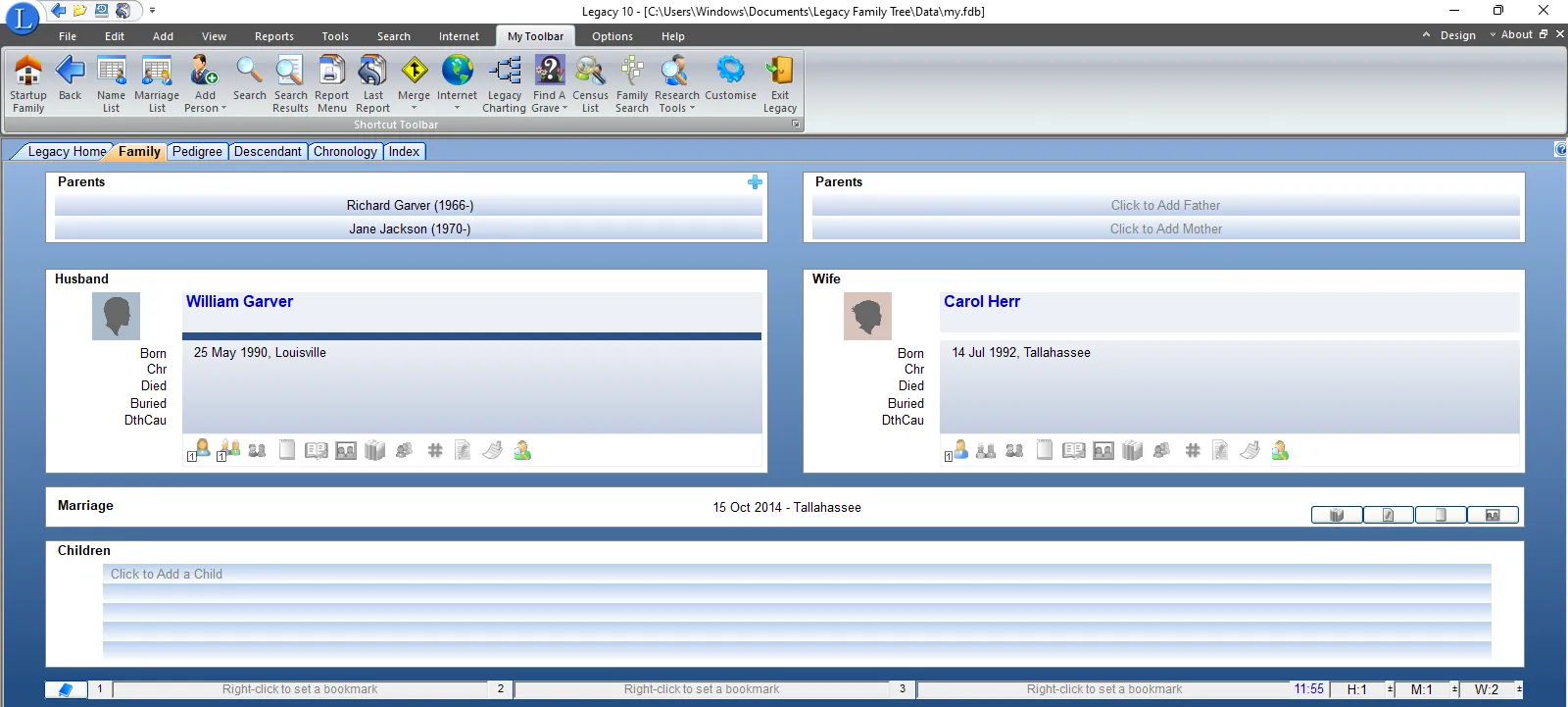
In terms of functionality, Legacy Family Tree has everything you need to conduct high-quality genealogical research. The user can add any information about their relatives: important life events or photographs. There is also a feature to search for additional information through various databases, including Family Search.
There is a built-in tool to visualize family connections and create a website.
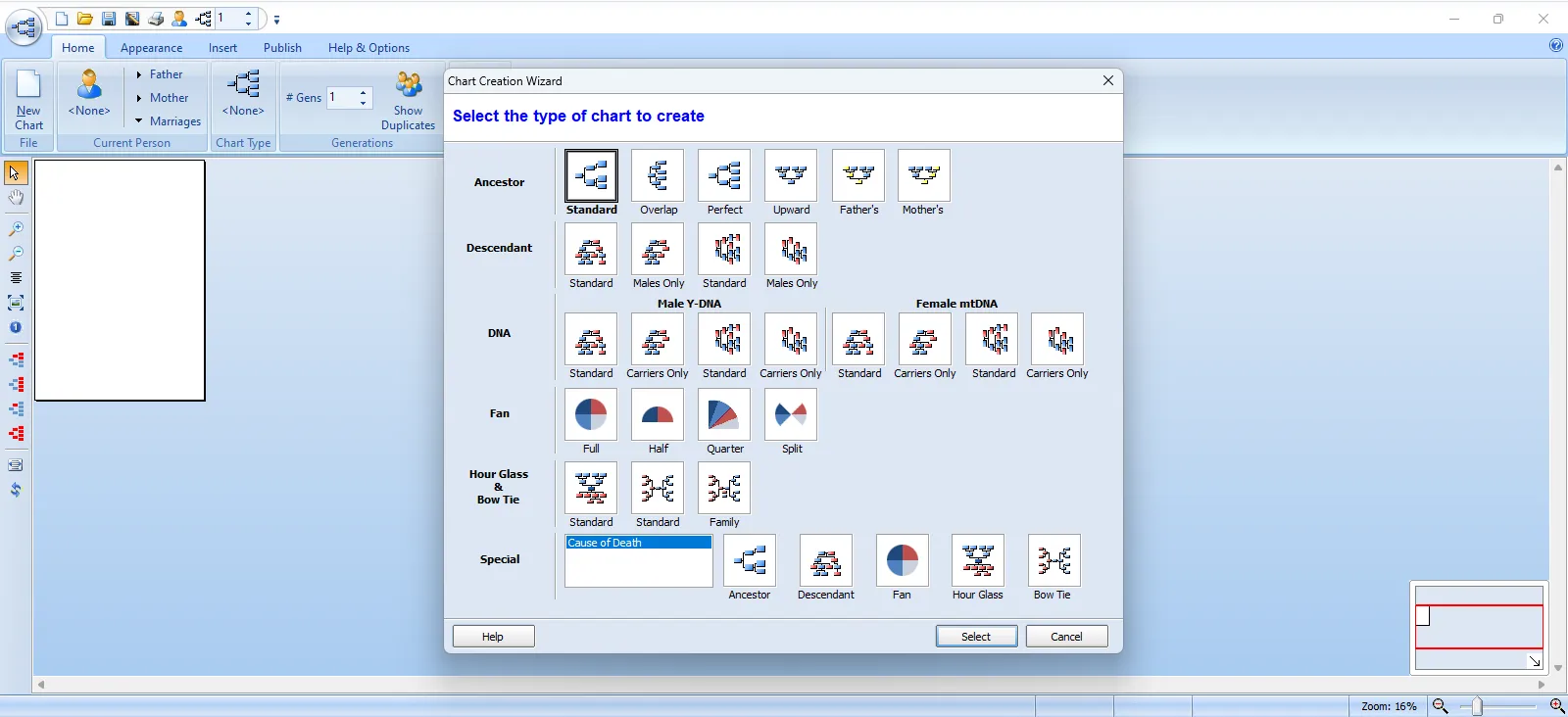
Advantages and Disadvantages
- The program supports many functions for creating and editing family trees, including detailed biographical information, multimedia management, document storage and genealogical records.
- Users can import and export GEDCOM files, which allows you to transfer information between different genealogical programs and databases.
- It also connects to various databases, providing users with access to millions of records and archives, which greatly simplifies the search for new data.
- The built-in designer for visualizing the family tree allows you to create only simple diagrams.
- The program requires a lot of computer resources, especially when working with large databases and multimedia files.
- New users might find the outdated interface and the many features challenging to navigate.
Family Historian
- Detailed construction of the family tree
- Various reports and visualizations
Family Historian is specialized software for genealogical research, developed by Calico Pie Limited since 2002. This application is a powerful and easy-to-use tool for everyone who wants to create a family tree and analyze their family lineage in detail. Users can also upload data to Findmypast and MyHeritage.
The Family Historian interface may seem overly complicated at first because there are many fields to fill out. However, the layout of all the functions is good, making it easy to understand.
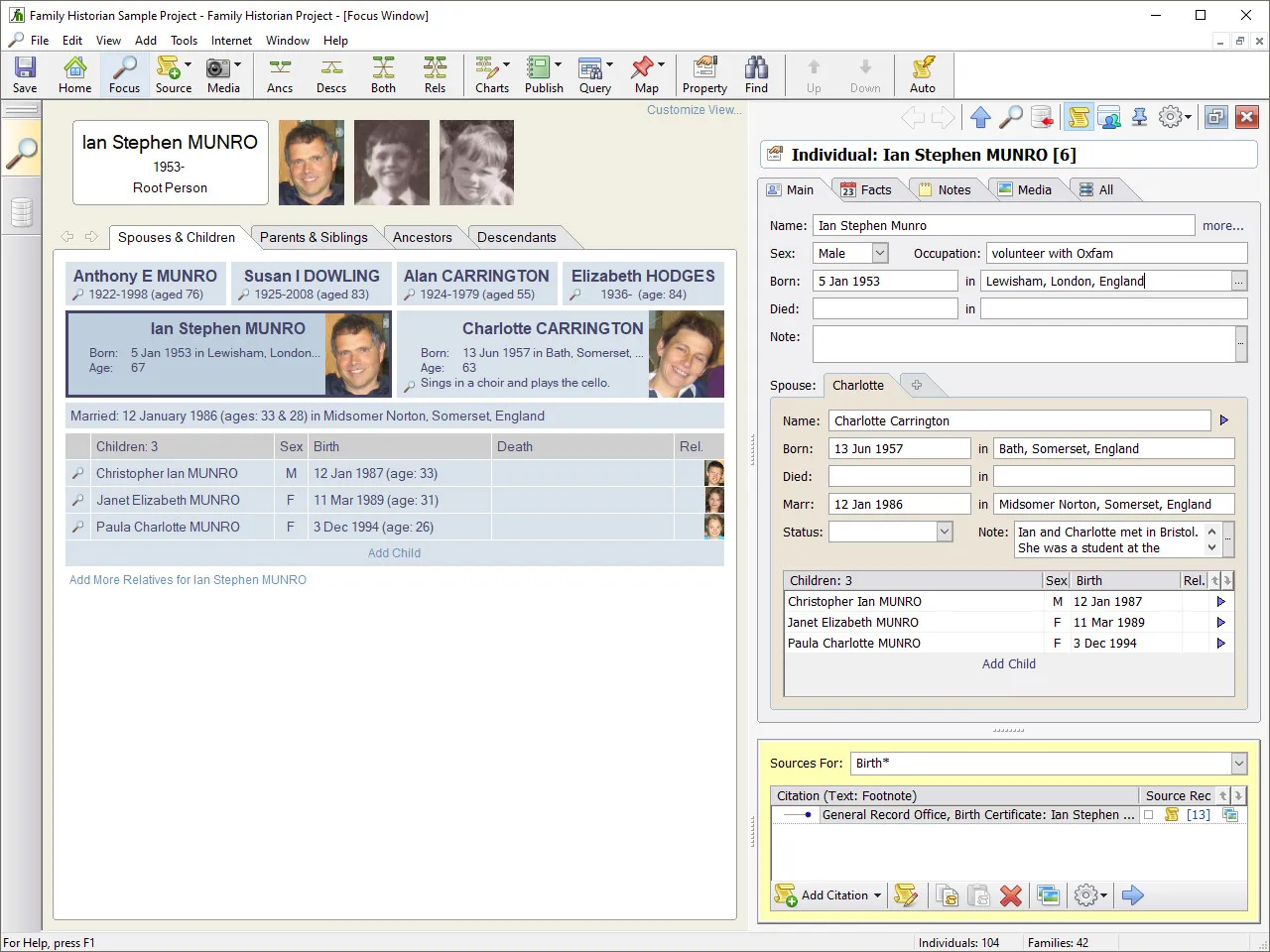
The tree visualization is interactive. This means that when you click on a particular person, the connections automatically rearrange themselves based on that person.
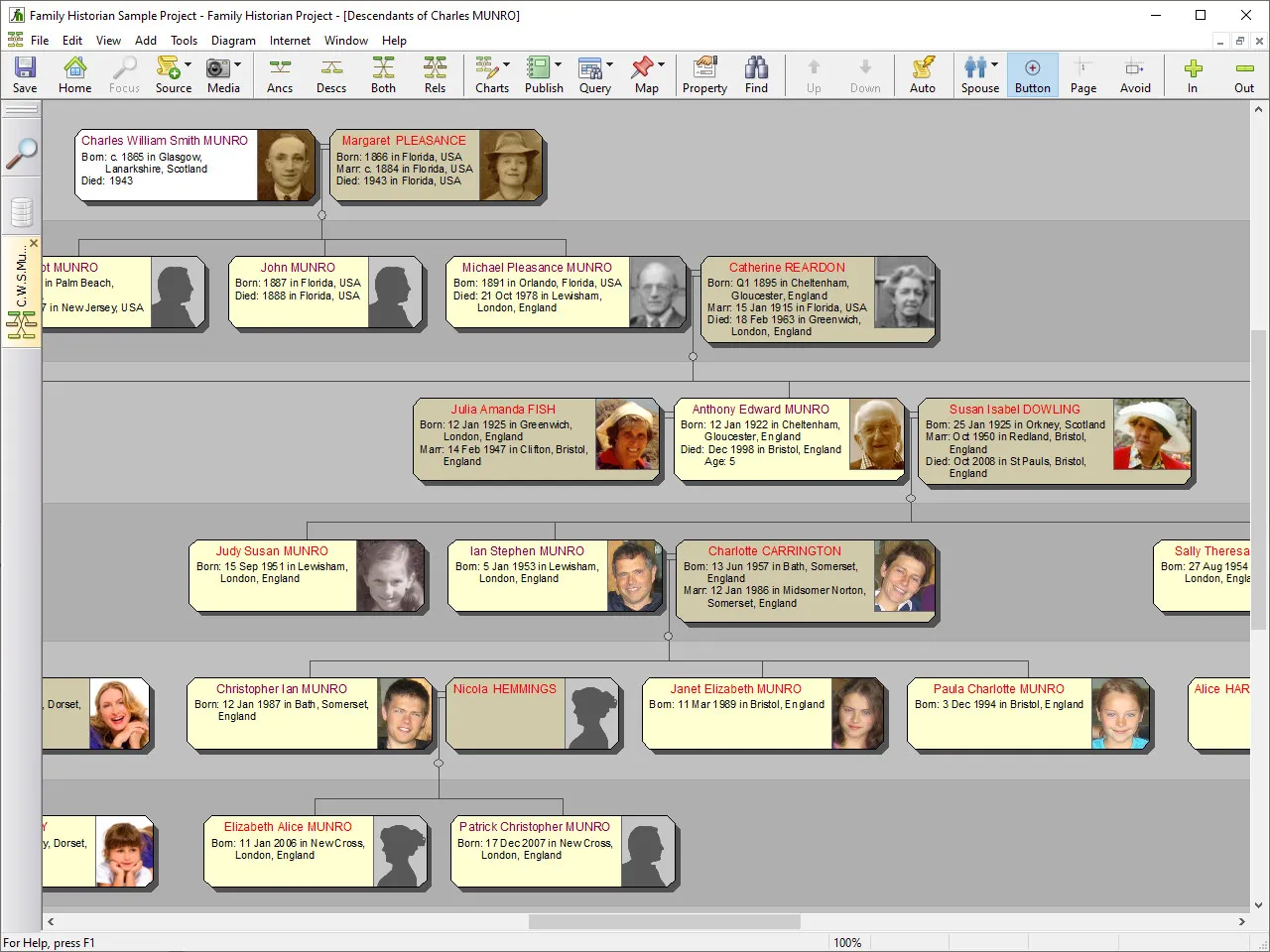
There is a face recognition function, which allows you to link each person to a specific photo.
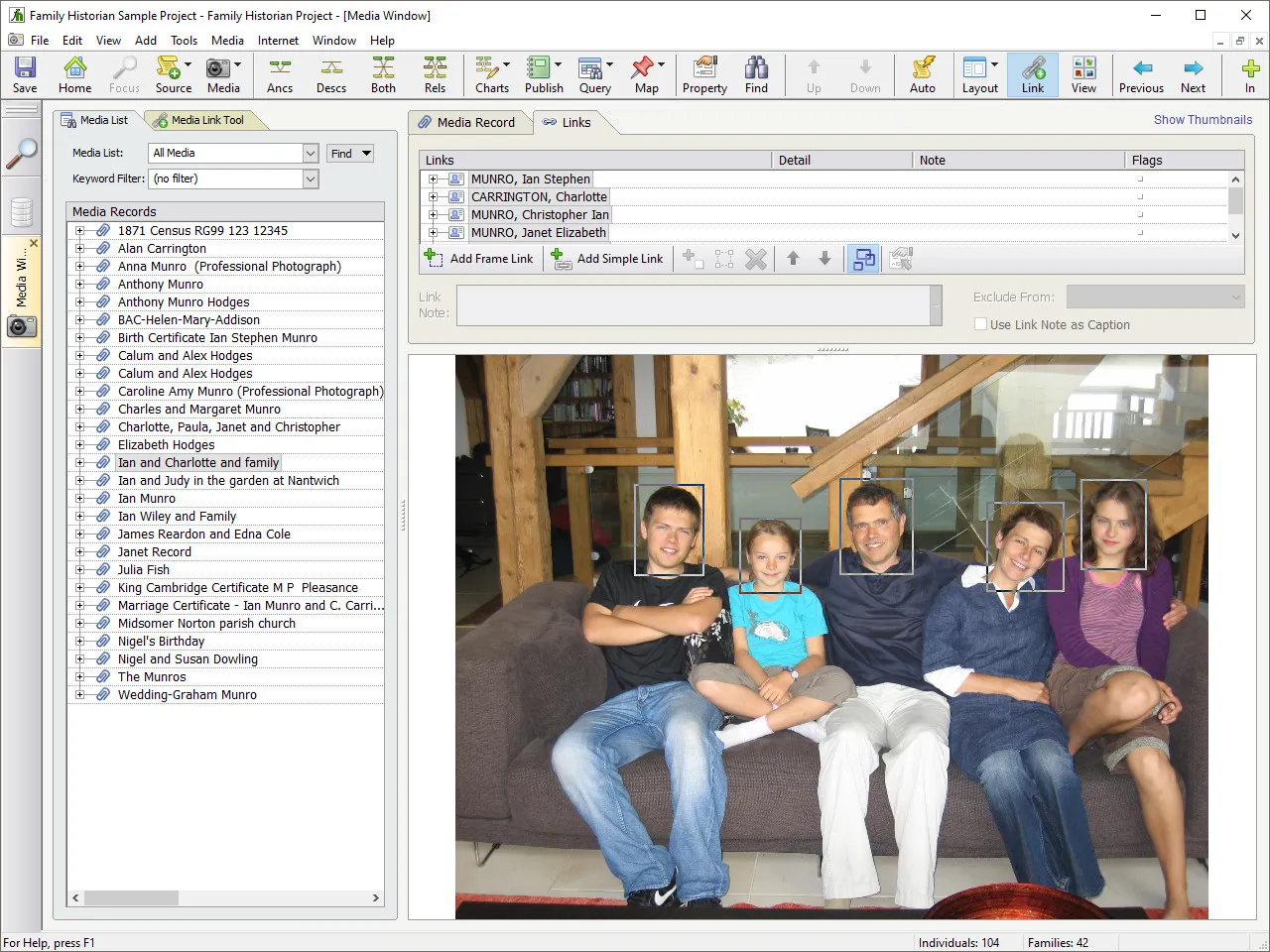
The program cannot generate beautiful pictures for printing a family tree, but it can generate genealogical booklets.
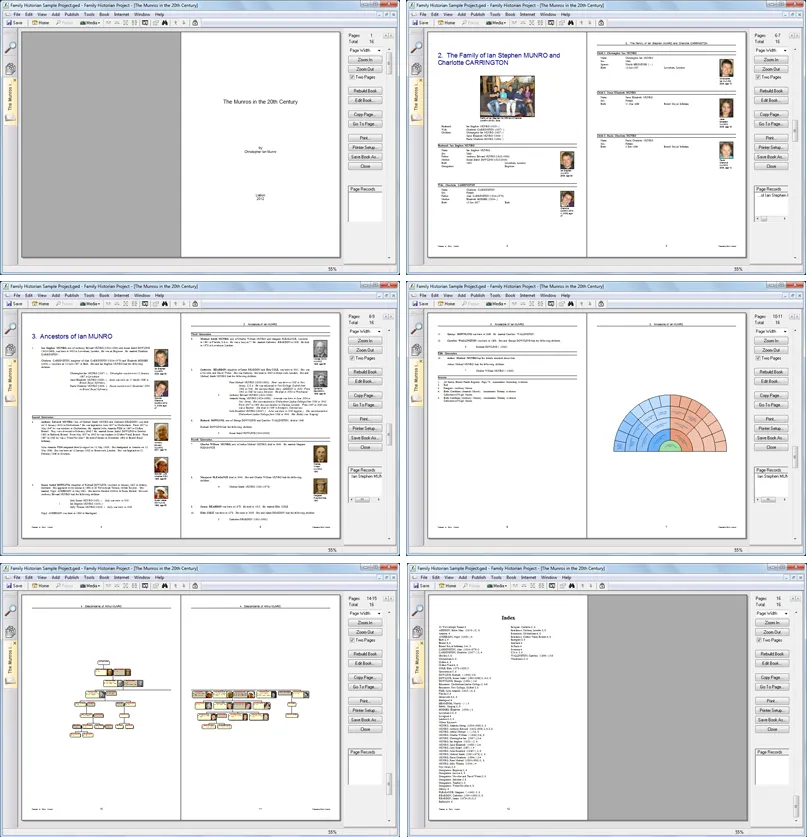
Advantages and Disadvantages
- Supports detailed family tree creation providing many fields for storing information about relatives, which allows you to take even the smallest details into account.
- Users can create a variety of reports and charts to visualize relationships, historical dates and important events, which makes working with data more demonstrative.
- The program allows you to attach photos, videos and documents to profiles, providing rich visual content for each family member.
- Family Historian is a paid program, which might be a drawback for users looking for free family tree solutions.
- The program has less integrated search functions in online archives compared to its competitors.
Tribalpages
- Creation of a full-fledged website with a family tree
- Wide range of functions and tree printing
Tribalpages is a little different from other family tree services, because it provides users with their own website that can be accessed via the Internet. Accordingly, anyone can view the information published on the site. At the same time, you can specify which sections are public and which are accessible only by invitation.
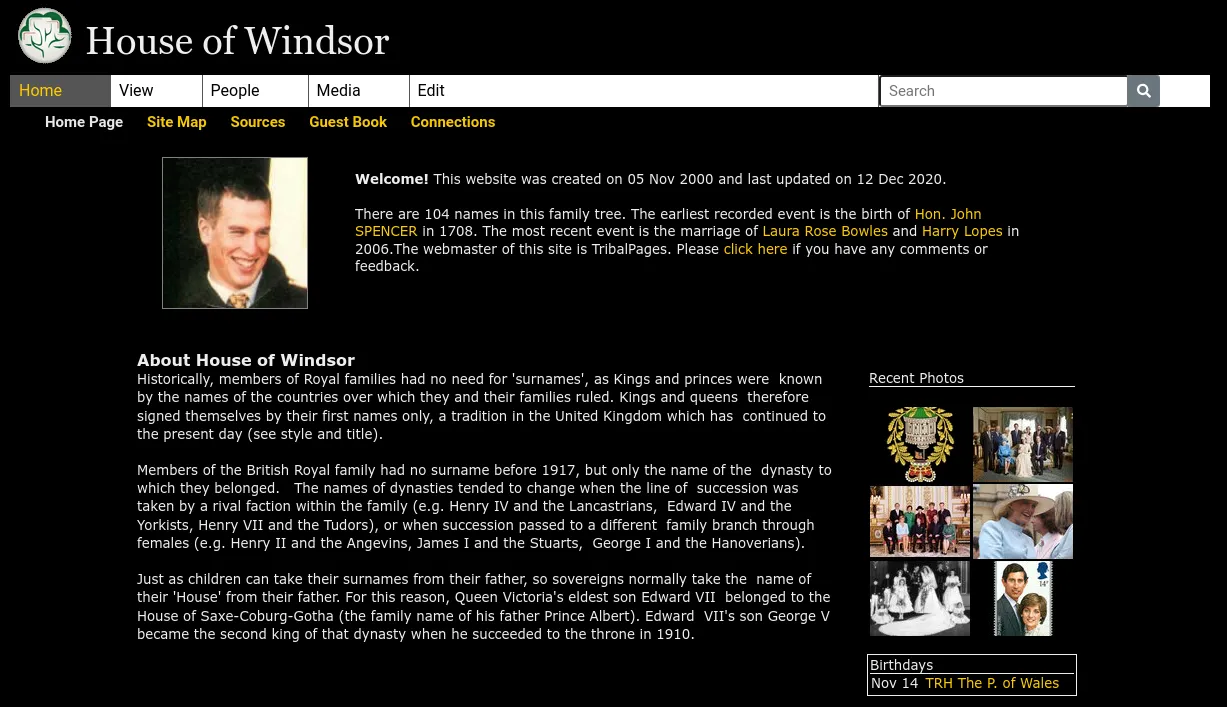
The site is populated by creating person profiles through a special form. If the information was collected in another program, it is possible to import data through the GEDCOM files.
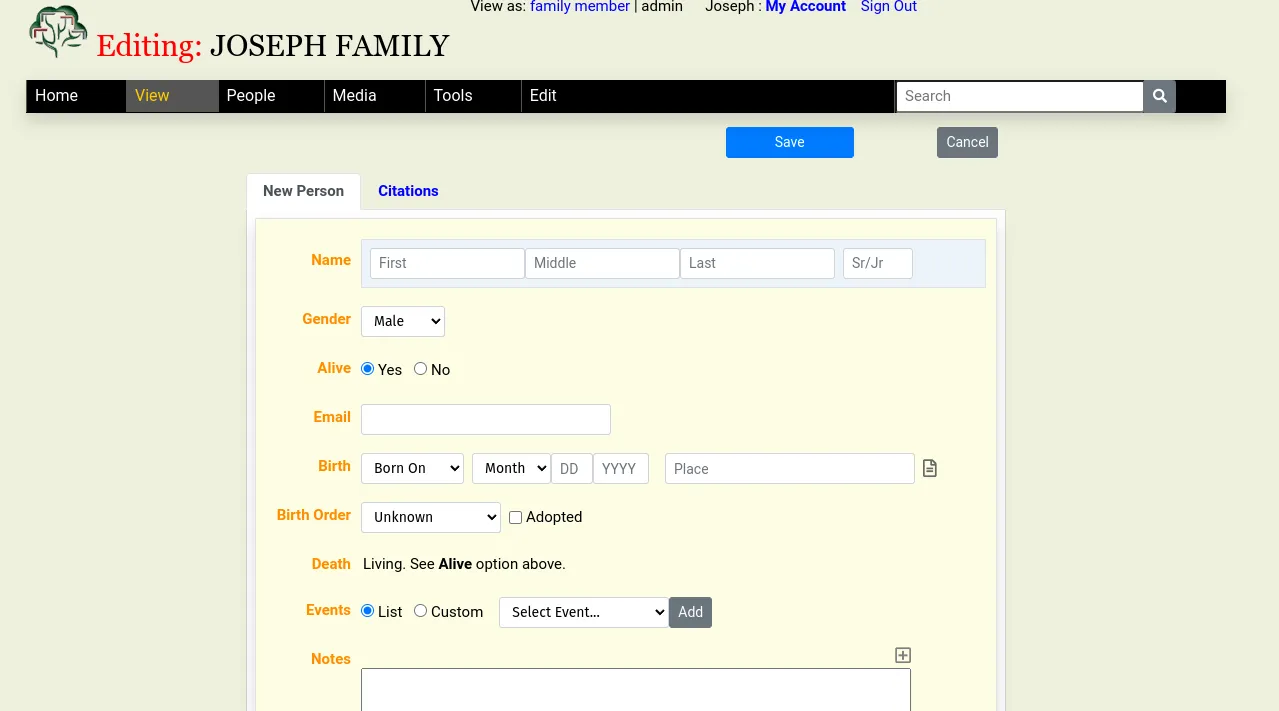
There are no limits on how extensive your family tree can be; if you have enough information, you can create a detailed tree for each person.
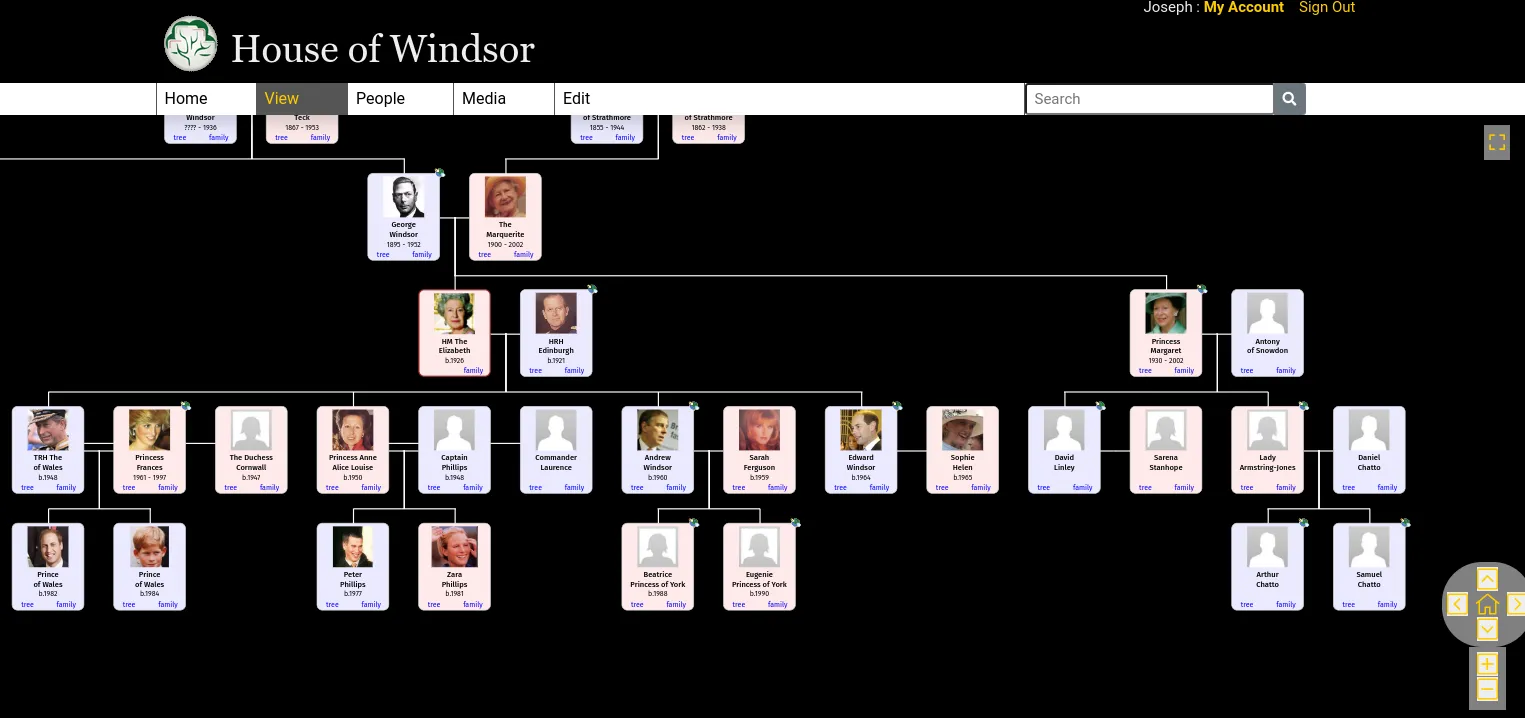
One notable feature is the ability to generate a printable family tree image. You just need to select a key person and the service will automatically fill in the names of all ancestors and descendants.
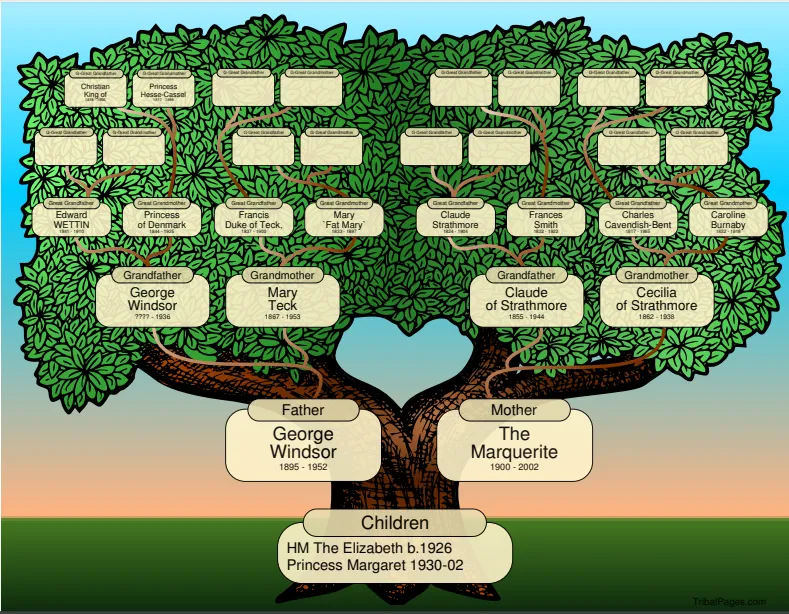
Advantages and Disadvantages
- The service offers a wide range of functions, including creating charts, reports, maps, adding photos, stories and documents.
- TribalPages provides the ability to create a printable family tree image, which can be useful for keeping records or as a gift.
- You can invite family members to help with the tree and give them different levels of access.
- You can control who can view or edit your tree, making it easy to manage privacy.
- The service offers a lot of settings for each profile and the tree overall, which can be confusing for beginners. Some sections and functions might not be easy to find because of the site’s navigation.
RootsMagic
RootsMagic is a program for creating a family tree, which allows you not only to draw a diagram of connections between relatives and ancestors, but also to collect detailed information about each person, including their health status and DNA test results. The interface is well-designed, making it easy to enter all this data.
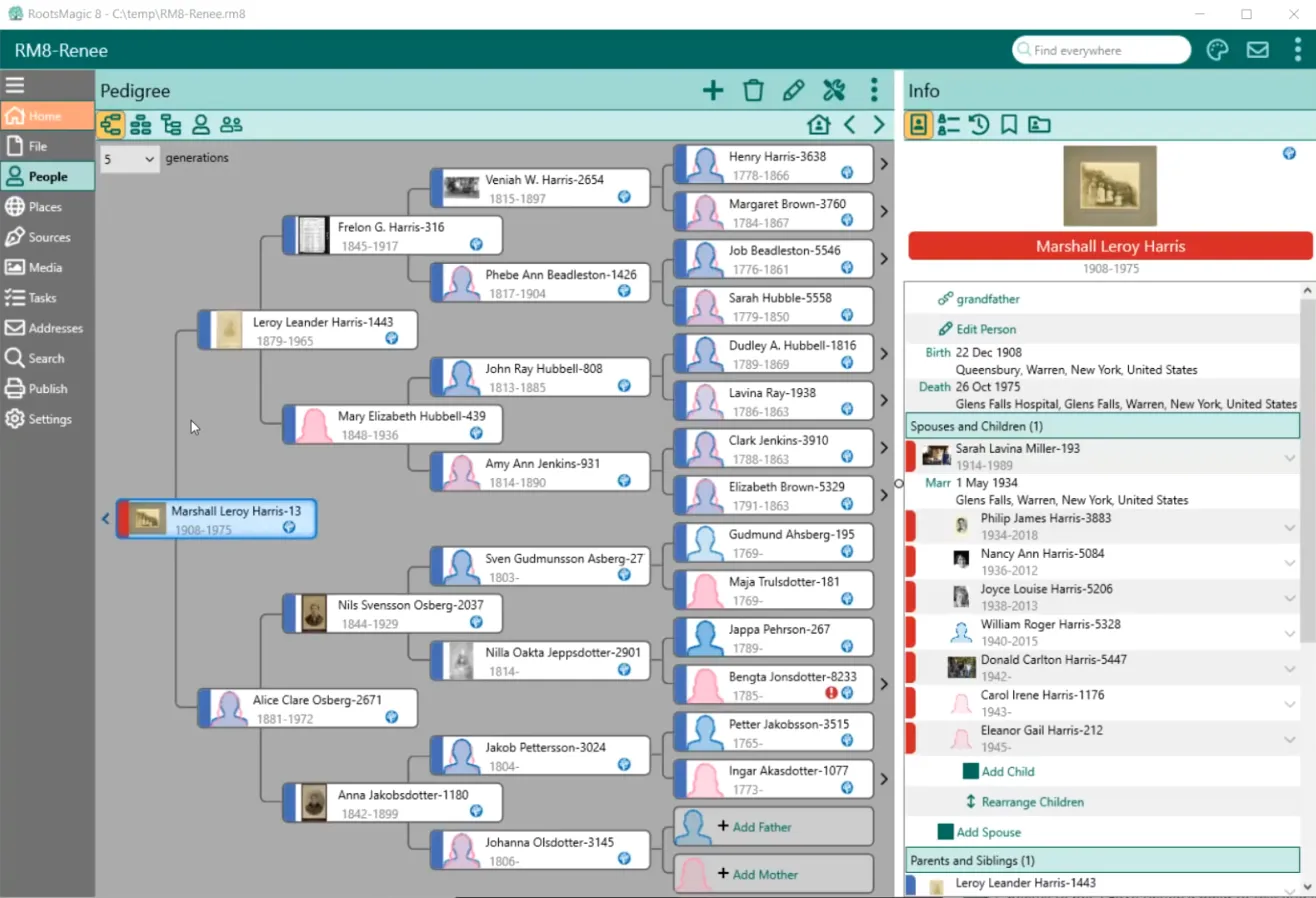
It is worth noting that you can create reports based on health information that will help you find out the predetermination of the current generation to certain diseases.
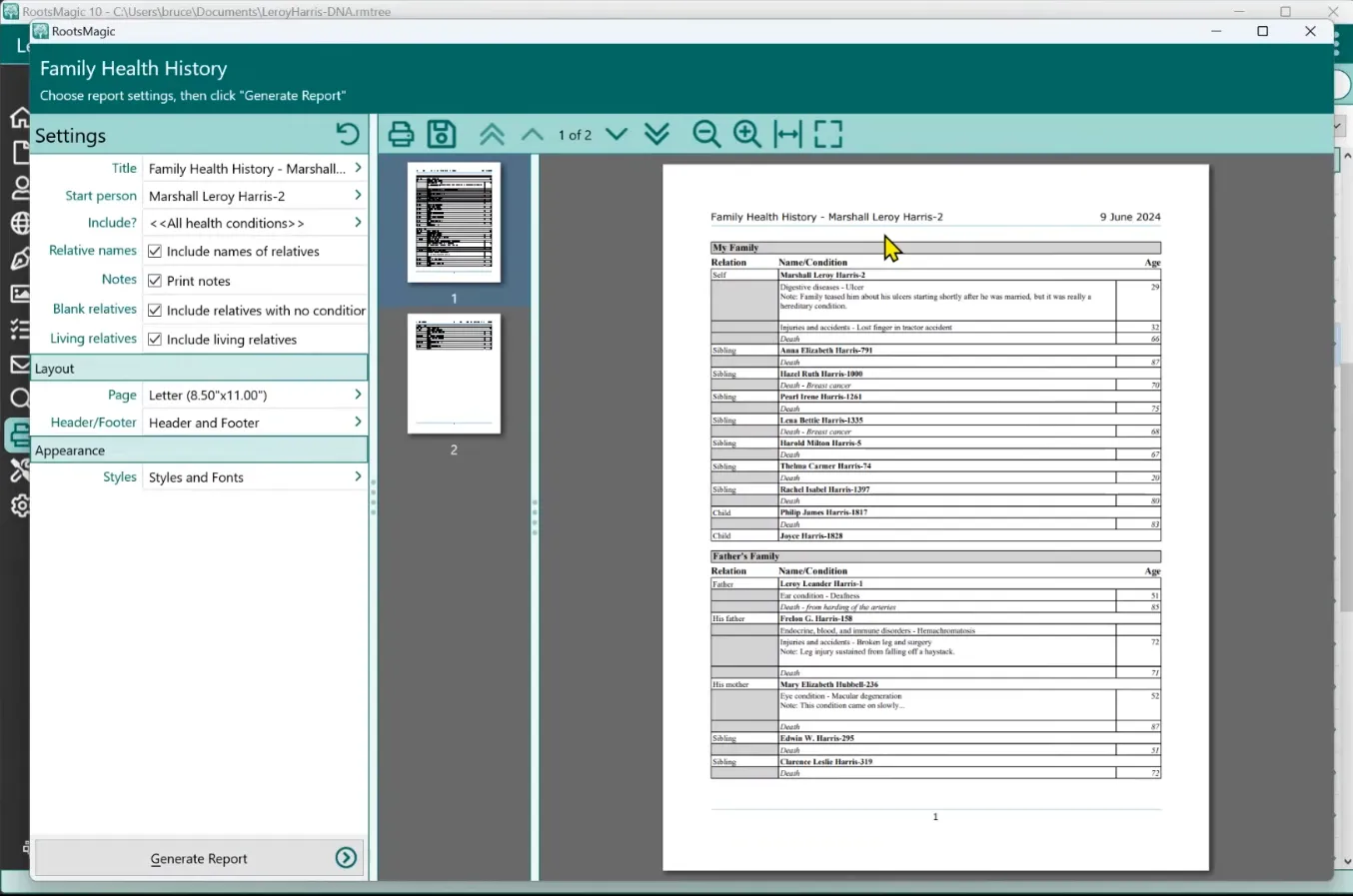
The program works well with GEDCOM files and supports most tags, so if you ever want to switch to another program, you can do so without any issues. RootsMagic integrates with Ancestry and FamilySearch, allowing you to obtain additional data from the archive databases of these services without leaving the program. However, this feature is only available in the paid version; the free version only allows you to add information manually and has limitations on the number of available family connection visualizations.
There are tools to export the family tree as an image for further printing.
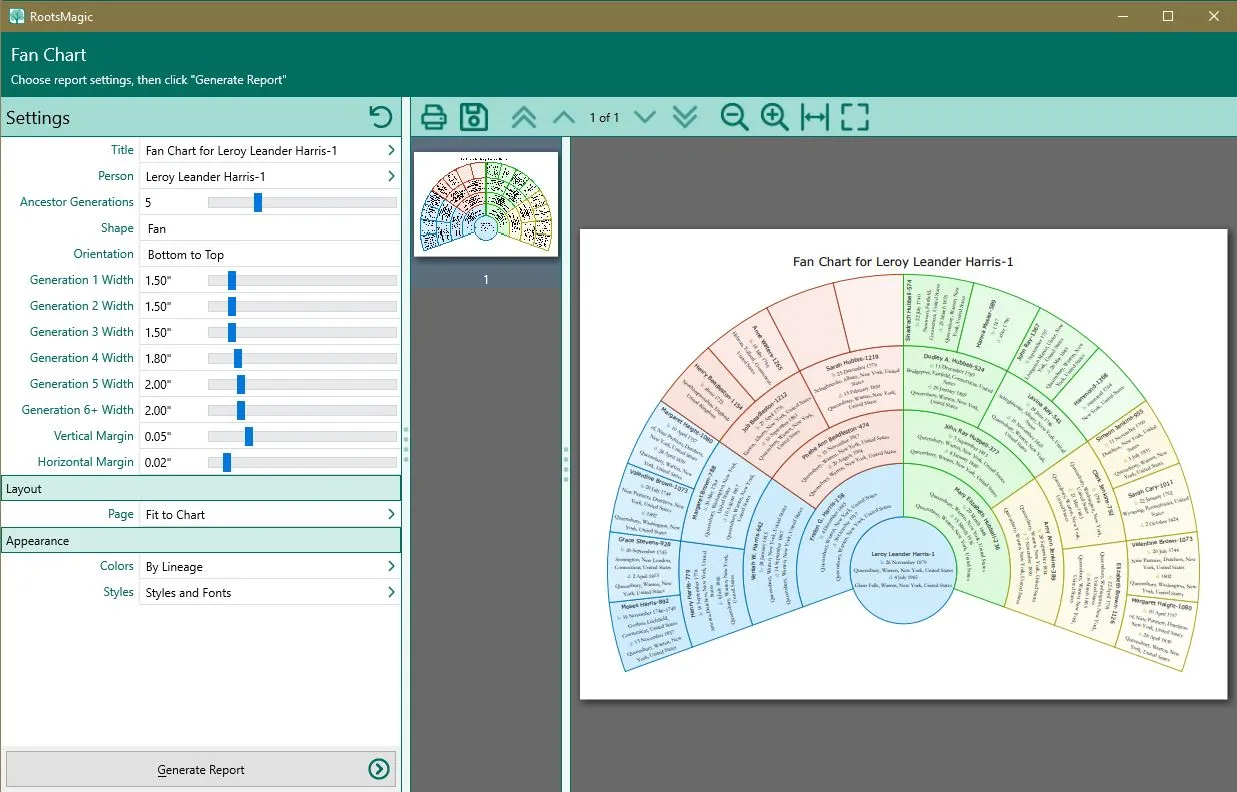
Advantages and Disadvantages
- The program integrates with popular genealogy databases like Ancestry and FamilySearch, making it much easier to find ancestor information and add it to your tree.
- RootsMagic supports GEDCOM export and import, making it easy to move data between different genealogy programs.
- It also offers a variety of customizable reports and charts, which help visualize and analyze family connections.
- Although the interface is user-friendly, beginners may need some time to learn how to use all of its features.
- The free version of RootsMagic has limited functionality that requires the purchase of a perpetual license to access more advanced features.
Gramps
Gramps is a free, open-source program designed to collect and organize data during genealogical research. Like many projects developed by enthusiasts, the program is not easy-to-use and doesn’t have a simple interface. In addition, some functions work strangely or incorrectly. For example, in Gramps you can't scale the tree, only move it around, which can be challenging for large-scale genealogical research. To enter a person's date of birth or death, you need to create a separate field in their profile, select an event, and then enter a specific value.
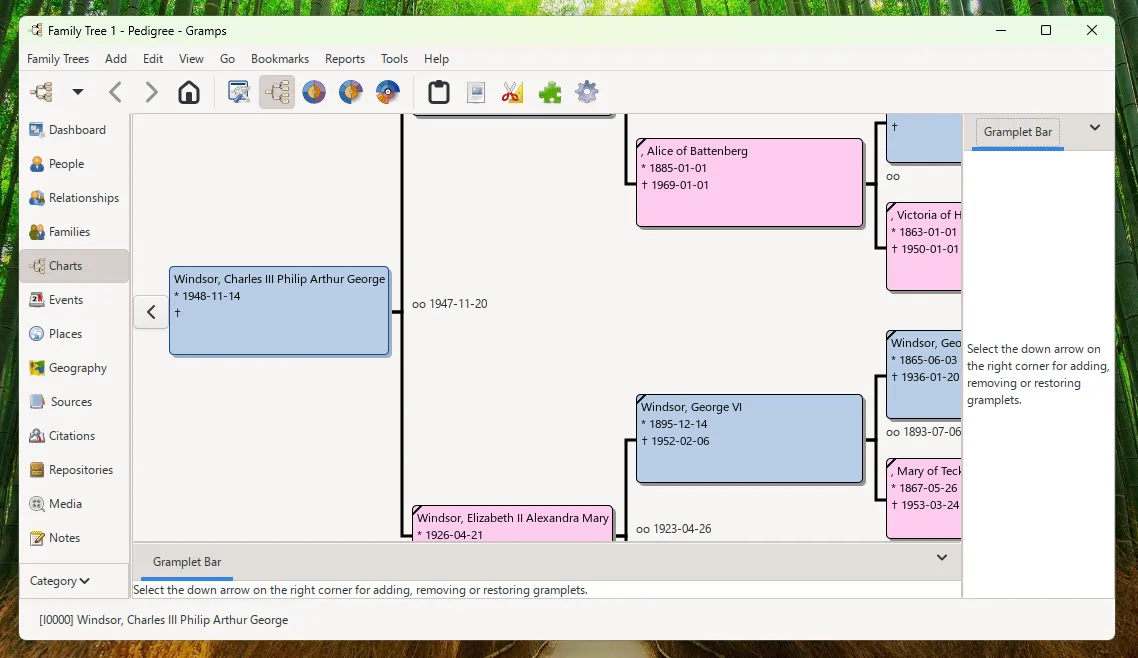
Advantages and Disadvantages
- Gramps is free and open source.
- It has many customizable settings that allow users to adapt the program to their needs. The user can add and edit fields, as well as customize report types.
- Gramps allows you to record extensive information about family members, such as dates, photos, sources, relationships, and more.
- The program interface is inconvenient. There are many functions and settings that can confuse not only a novice but also an experienced user.
- When working with large databases, Gramps uses a significant amount of computer resources, which can result in its slower performance.
- There is no built-in function for exporting/importing genealogical data from popular online databases.
- You cannot create printable family tree images, which limits your visualization options.
Ancestris
Ancestris is a free genealogical research program created and developed by a community of enthusiasts. One of its unique features is that it works not only on Windows but also on macOS and Linux. . Compatibility is ensured by the fact that Ancestris is a program that is written entirely in JAVA, so you need to have appropriate Software from Oracle installed on your computer for it to run.
This design provides excellent compatibility, but also has disadvantages related to JAVA. Starting the program can take some time because the Java Virtual Machine (JVM) needs to boot up and initialize. Loading the database causes increased use of your computer's RAM and CPU, which negatively impacts the overall performance of Ancestris.
Despite these technical issues, the presented program offers good features for creating a detailed family tree. At the same time, the interface is simple and displays the necessary tools clearly.
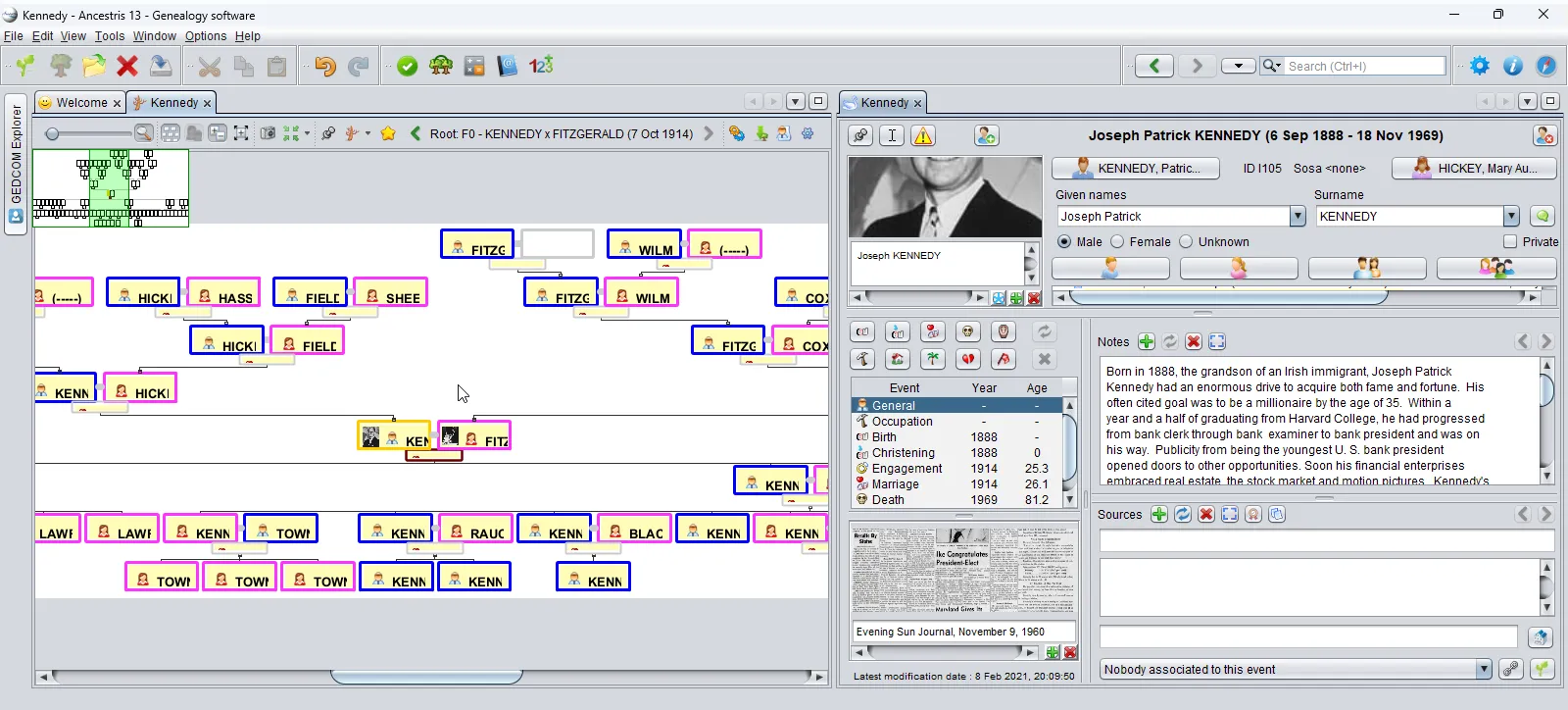
Ancestris supports adding multimedia files like photos or scans of documents to enrich a person’s profile.
Ancestris allows you to trace your ancestors’ movements and the events in their lives based on location information.
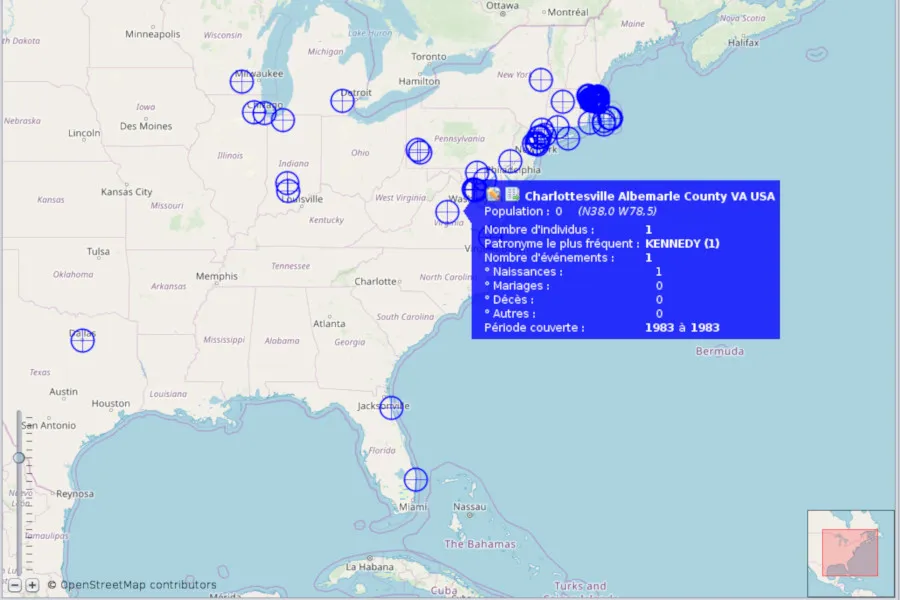
Ancestris supports the export and import of data in the GEDCOM format, which is the international standard for storing genealogical information. This allows you to easily exchange information with other similar programs and web services. Ancestris provides flexible data display settings, you can customize your family tree according to your preferences.
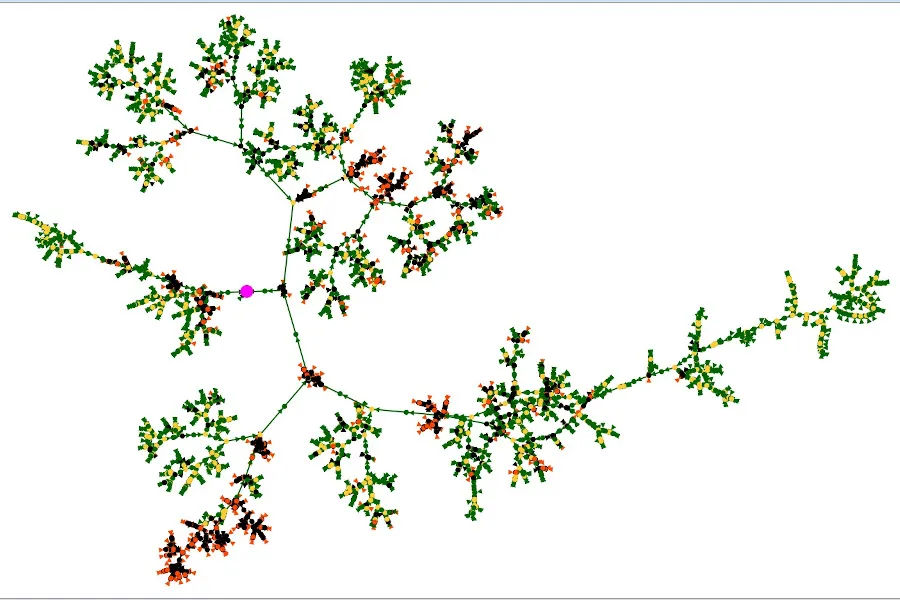
Advantages and Disadvantages
- The program provides an easy-to-use interface for creating a family tree. You can add multimedia files and edit profiles easily.
- There are versions for Windows, macOS and Linux, which allows you to work on different operating systems without losing functionality.
- Ancestris displays events on the map to trace the movements of ancestors and the chronology of their lives.
- Since the program is written in Java, it requires the installation of an appropriate runtime environment (JVM), which can be challenging for non-technical users.
- When loading large databases, Ancestris can use a lot of RAM and CPU resources, which may slow down your system.
- Due to the need to initialize the JVM, launching the program may take longer compared to others that run directly on your operating system.
- Does not have family tree visualization functions.
Conclusion
Choosing a program or service for building a family tree can be difficult because of the many features available. Decide what is most important to you and it will be easier for you to find the right tool.
If you want to create a beautiful family tree quickly and print it right away, pay attention to Tonfotos. This tool not only provides you with a finished result, but also helps organize your family photo collection.
If you want a free service with a large database, then FamilySearch is a great option. If you're ready to pay for extra features and DNA testing, then Ancestry might be a better choice. MyHeritage offers unique features like photo animation, but also requires a subscription for full access.
For those who value simplicity and ease of use, Findmypast and Tribalpages may be attractive options, but they have some limitations. Legacy Family Tree and Ancestris are powerful tools, but they can be challenging for beginners. Gramps is open source, but not user-friendly. Family Historian and RootsMagic offer extensive functionality, but they are paid. Heredis is a professional tool, but rather expensive.
Ultimately, the best way to choose a program or service is to determine your needs and priorities, and then explore the options presented in this review.